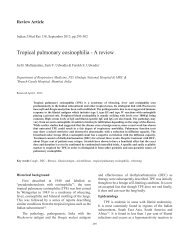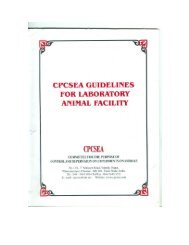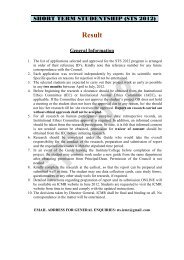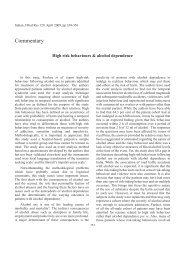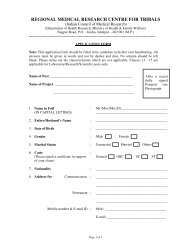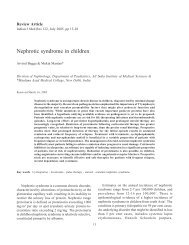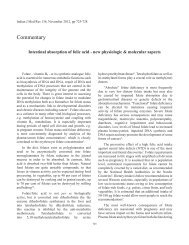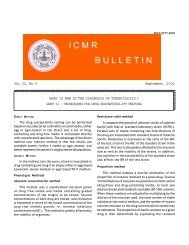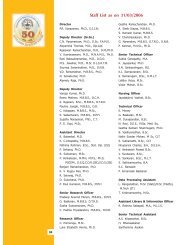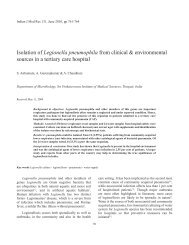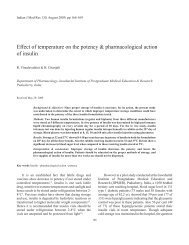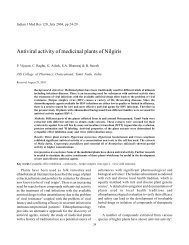Use of Animals in Scientific Research - Indian Council of Medical ...
Use of Animals in Scientific Research - Indian Council of Medical ...
Use of Animals in Scientific Research - Indian Council of Medical ...
- TAGS
- scientific
- icmr.nic.in
Create successful ePaper yourself
Turn your PDF publications into a flip-book with our unique Google optimized e-Paper software.
<strong>Use</strong> <strong>of</strong> <strong>Animals</strong><br />
<strong>in</strong><br />
<strong>Scientific</strong> <strong>Research</strong><br />
May 2000<br />
Prepared By<br />
N. V. Giridharan<br />
NCLAS, Hyderabad<br />
Vijay Kumar<br />
Vasantha Muthuswamy<br />
ICMR, New Delhi<br />
<strong>Indian</strong> <strong>Council</strong> <strong>of</strong> <strong>Medical</strong> <strong>Research</strong><br />
M<strong>in</strong>istry <strong>of</strong> Health & Family Welfare<br />
New Delhi<br />
1
1. Introduction<br />
rom time immemorial, man has depended on animals for his survival, either<br />
F<br />
as food (cattle, sheep, pigs, poultry etc.) or for competition and<br />
companionship (horse, dog, cat, parrots etc.). As he knew more about his<br />
surround<strong>in</strong>gs, he extended this dependence to acquisition <strong>of</strong> knowledge, dat<strong>in</strong>g back to<br />
the days <strong>of</strong> the great physician Galen (129-200 AD), who used animals to demonstrate<br />
that arteries conta<strong>in</strong>ed blood and not air. We have come a long way s<strong>in</strong>ce then and<br />
specially bred laboratory animals consist<strong>in</strong>g <strong>of</strong> mice, rats, hamsters, gu<strong>in</strong>ea pigs, rabbits,<br />
cats, dogs, monkeys, higher farm animals and a variety <strong>of</strong> birds and other lower forms are<br />
now <strong>in</strong>tegral part <strong>of</strong> biomedical research.<br />
2. Why are animals used <strong>in</strong> experiments ?<br />
“<strong>Research</strong> , <strong>in</strong> reality, <strong>in</strong>volves three facets : acquisition <strong>of</strong> new knowledge, use <strong>of</strong><br />
animals <strong>in</strong> teach<strong>in</strong>g exercises, and the test<strong>in</strong>g <strong>of</strong> compounds, chemicals or devices for<br />
safety and effectiveness. There must be reasonable expectation that research <strong>in</strong>volv<strong>in</strong>g<br />
animals will contribute significantly to present and future knowledge, which may<br />
eventually lead to the protection and improvement <strong>of</strong> the health and welfare <strong>of</strong> either<br />
humans or animals. World over, new drug research as well as tests meant for assur<strong>in</strong>g the<br />
quality and efficacy <strong>of</strong> pharmaceutical products /vacc<strong>in</strong>es/biological are based on<br />
experiments <strong>in</strong>volv<strong>in</strong>g animals. Toxicological studies specially those performed <strong>in</strong><br />
rodents and beagle dogs are the essential l<strong>in</strong>k between the pre cl<strong>in</strong>ical phase and cl<strong>in</strong>ical<br />
development <strong>of</strong> the drug molecule. No new drug can be <strong>in</strong>troduced <strong>in</strong> cl<strong>in</strong>ical practice or<br />
even for the matters <strong>in</strong>to cl<strong>in</strong>ical research unless it passes the battery <strong>of</strong> toxicity tests <strong>in</strong><br />
animals.<br />
Human biology is very much like that <strong>of</strong> many other animals. That is why, results from<br />
animal experiments apply to people. Most laboratory animals have the same set <strong>of</strong> organs<br />
- heart, lungs, liver, and so on which work <strong>in</strong> the same way as they do <strong>in</strong> humane. There<br />
are seven major areas <strong>of</strong> medic<strong>in</strong>e and biology where animals for experiments need to be<br />
used.<br />
i. Fundamental biological and medical research - This is necessarily to be undertaken<br />
as to unravel the secrets <strong>of</strong> nature. If we essentially know how different tissues and<br />
organs are kept healthy, we can then f<strong>in</strong>d out what goes wrong when disease strikes.<br />
Fundamental research <strong>in</strong> biology and medic<strong>in</strong>e are basic foundations on which future<br />
discoveries are based.<br />
ii. Develop<strong>in</strong>g new treatments for diseases - To conquer disease, a lot <strong>of</strong> work needs to<br />
be put <strong>in</strong>to, by way <strong>of</strong> develop<strong>in</strong>g better medic<strong>in</strong>es, perfect<strong>in</strong>g surgical operations as<br />
well as mak<strong>in</strong>g vacc<strong>in</strong>es and f<strong>in</strong>d<strong>in</strong>g other ways <strong>of</strong> prevent<strong>in</strong>g diseases. Even though<br />
2
much <strong>of</strong> this work is for humans, many <strong>of</strong> them are applicable to animals as well, and<br />
even some are exclusively for animals. There are many diseases which are yet to<br />
have a proper cure like multiple sclerosis, certa<strong>in</strong> cancers, as well as new diseases<br />
like AIDS, Alzheimer disease etc. All these need <strong>in</strong>itial <strong>in</strong>put <strong>in</strong> terms <strong>of</strong> animal<br />
experiments.<br />
iii. Preparations <strong>of</strong> natural products used <strong>in</strong> medical research and treatment -<br />
<strong>Animals</strong> can produce useful medical substances <strong>in</strong> their blood or milk, like<br />
antibodies, vacc<strong>in</strong>es and hormones which are important for diagnostic tests, medical<br />
treatments, and basic research. May be at a later date, we can produce all these<br />
synthetically, but at present, most <strong>of</strong> them are produced us<strong>in</strong>g animals.<br />
iv. Safety test<strong>in</strong>g <strong>of</strong> chemicals and drugs - A wide range <strong>of</strong> chemicals and medic<strong>in</strong>es<br />
which are used <strong>in</strong> day-to-day life, as household products, <strong>in</strong> farm<strong>in</strong>g, <strong>in</strong>dustry etc.,<br />
need to be tested for their safe use <strong>in</strong> humans as well as <strong>in</strong> animals. Such prelim<strong>in</strong>ary<br />
test<strong>in</strong>g is very much essential for avoid<strong>in</strong>g pollution and associated health hazards<br />
and proper healthy ma<strong>in</strong>tenance <strong>of</strong> the environment.<br />
v. Study <strong>of</strong> genetic disorders - There are many diseases which are <strong>in</strong>herited fully or<br />
partially and are caused by basic faults <strong>in</strong> a person's genetic code. Some <strong>of</strong> the<br />
animals also have similar genetic fault as humans do. There are mutant stra<strong>in</strong>s like<br />
dystrophic mice which have the same faulty gene as the muscular dystrophic patients.<br />
The animal thus plays a vital role <strong>in</strong> understand<strong>in</strong>g and treatment <strong>of</strong> such genetic<br />
diseases. Scientists have now made such progress <strong>in</strong> molecular biology that they can<br />
now alter genes and breed stra<strong>in</strong>s <strong>of</strong> mice and other animals with particular genetic<br />
diseases. This may ultimately lead to treatments <strong>in</strong> genetic disorders like cystic<br />
fibrosis, sickle cell anaemia and other diseases which run <strong>in</strong> families.<br />
vi. Development <strong>of</strong> new diagnostic tests for diseases - If the treatment <strong>of</strong> a disease is to<br />
be effective, an accurate and quick diagnosis is essential. Animal experiments are<br />
vital <strong>in</strong> this area, which <strong>in</strong>clude scann<strong>in</strong>g <strong>of</strong> unborn babies for identify<strong>in</strong>g cancers,<br />
diagnose heart diseases etc. Animal tests have paved the way for many blood tests<br />
for the diagnosis <strong>of</strong> <strong>in</strong>fectious diseases.<br />
vii. In biology and medical education - The animals are to be used <strong>in</strong> teach<strong>in</strong>g biology<br />
<strong>in</strong> schools and colleges <strong>in</strong> understand<strong>in</strong>g the basic anatomy and physiology <strong>of</strong> man<br />
and other animals.<br />
<strong>Medical</strong> <strong>Research</strong> <strong>in</strong> the last 100 years has facilitated many ways to treat and prevent diseases<br />
<strong>in</strong> humans as well as <strong>in</strong> animals. Table 1 lists some <strong>of</strong> the ma<strong>in</strong> discoveries <strong>in</strong> basic research<br />
related to animals experiments. The development <strong>of</strong> many major medical treatments has also<br />
depended on animal research. Table 2 lists some <strong>of</strong> the well known examples <strong>of</strong> these.<br />
1
TABLE 1<br />
MAJOR ADVANCES IN BASIC RESEARCH THAT DEPENDED ON<br />
ANIMAL EXPERIMENTS<br />
1600's - Discovery <strong>of</strong> blood circulation<br />
Discovery <strong>of</strong> the function <strong>of</strong> the lungs<br />
1700's - Measurement <strong>of</strong> blood pressure<br />
1800's - Vacc<strong>in</strong>ation to stimulate immunity<br />
Understand<strong>in</strong>g <strong>of</strong> <strong>in</strong>fectious diseases<br />
1900's - Discovery <strong>of</strong> antibodies<br />
Understand<strong>in</strong>g <strong>of</strong> hormone systems<br />
1920's - Discovery <strong>of</strong> vitam<strong>in</strong>s<br />
1930's - Discovery <strong>of</strong> the mechanism <strong>of</strong> nerve impulses<br />
Discovery <strong>of</strong> tumour viruses<br />
1940's - Understand<strong>in</strong>g <strong>of</strong> embryonic development<br />
1950's - Understand<strong>in</strong>g <strong>of</strong> the control <strong>of</strong> muscle activity<br />
Understand<strong>in</strong>g <strong>of</strong> energy metabolism<br />
Understand<strong>in</strong>g the mechanism <strong>of</strong> hear<strong>in</strong>g<br />
1960's - Discovery <strong>of</strong> monoclonal antibodies<br />
Understand<strong>in</strong>g the biochemical functions <strong>of</strong> the liver<br />
1970's - Understand<strong>in</strong>g <strong>of</strong> transplantation antigens<br />
Understand<strong>in</strong>g the way the bra<strong>in</strong> functions<br />
Discovery <strong>of</strong> prostagland<strong>in</strong>s<br />
1980's - Development <strong>of</strong> transgenic animals<br />
Understand<strong>in</strong>g the basis <strong>of</strong> memory<br />
1990's - Understand<strong>in</strong>g auto-immune disorders<br />
In vitro fertilization, clon<strong>in</strong>g, gene manipulation<br />
2
TABLE 2<br />
MAJOR MEDICAL ADVANCES THAT DEPENDED ON<br />
ANIMAL RESEARCH<br />
1920's - Insul<strong>in</strong> for diabetes<br />
1930's - Modern anaesthetics for surgery<br />
Diphtheria vacc<strong>in</strong>e<br />
1940's - Broad-spectrum antibiotics for <strong>in</strong>fections<br />
Whoop<strong>in</strong>g cough vacc<strong>in</strong>e<br />
Heart-lung mach<strong>in</strong>e for open-heart surgery<br />
1950's - Kidney transplants<br />
Cardiac pacemakers and replacement heart valves<br />
Polio vacc<strong>in</strong>e<br />
Drugs for high blood pressure<br />
Hip replacement surgery<br />
1960's - Corneal transplants<br />
Rubella vacc<strong>in</strong>e<br />
Coronary bypass operations<br />
Heart transplants<br />
Drugs to treat mental illness<br />
1970's - Drugs to treat ulcers<br />
Improved sutures and other surgical techniques<br />
Drugs to treat asthma<br />
Drugs to treat leukaemia<br />
1980's - Immunosuppressant drugs for organ transplants<br />
CAT scann<strong>in</strong>g for improved diagnosis<br />
Life-support systems for premature babies<br />
Drugs to treat viral disease<br />
1990's - Laproscopic surgical techniques<br />
Breast Cancer L<strong>in</strong>ks<br />
Gene therapy for cystic fibrosis<br />
3
3. Opposition to animal use for research<br />
In spite <strong>of</strong> the advancement <strong>in</strong> biomedical research, and the benefits derived by the society<br />
through them, the opposition to animal experiments always existed. It has a long history,<br />
dat<strong>in</strong>g almost from the day animals were be<strong>in</strong>g used <strong>in</strong> biomedical research. From writ<strong>in</strong>g to<br />
peaceful protests <strong>in</strong> earlier days, the movement has become more violent <strong>in</strong> recent times,<br />
especially <strong>in</strong> Europe and America.<br />
The animal right movement which orig<strong>in</strong>ated <strong>in</strong> Europe and America does not seem to be due<br />
to any religious believes. The Bible, for example, is unequivocal about the position <strong>of</strong> animals<br />
<strong>in</strong> the natural order: `God made man <strong>in</strong> his image and gave him dom<strong>in</strong>ion over all other<br />
creatures'. On the other hand, oriental and particularly <strong>Indian</strong> attitude to animals is one that is<br />
t<strong>in</strong>ged with religious and ethical colours. H<strong>in</strong>duism and Buddhism envisage a hierarchy <strong>of</strong><br />
organisms rather than a sharp division. The H<strong>in</strong>du pantheon places many forms <strong>of</strong> plants,<br />
birds and animals on par with humans and deifies them. <strong>Animals</strong> and birds are thought not<br />
only as Vahanas or Vehicles on which God rides, but much more useful as well. Over the<br />
centuries this has brought about a very healthy respect <strong>in</strong> the <strong>Indian</strong> m<strong>in</strong>d for all forms <strong>of</strong> life.<br />
The cow is sacred not because it is a div<strong>in</strong>e vehicle alone, but because it has an overall utility<br />
value. Buddhism and Ja<strong>in</strong>ism carries this attitude further, lead<strong>in</strong>g to vegetarianism and<br />
respects for all liv<strong>in</strong>g be<strong>in</strong>gs. To the Sufis, steeped <strong>in</strong> equally considerate attitudes the<br />
prevalent <strong>Indian</strong> m<strong>in</strong>d set was extremely acceptable. Thus, <strong>in</strong> the east, regardless <strong>of</strong> specific<br />
sectar religions, the attitude to other life forms was not exploitative, but appreciative. Even<br />
pigs, boars, buffalos and monkeys are referred <strong>in</strong> holy books and the <strong>Indian</strong> m<strong>in</strong>d set can<br />
become easily sensitive when it comes to these animals. These religious sentiments could be<br />
one major reason why the animal activism <strong>in</strong> this country has found firm roots, while <strong>in</strong> the<br />
West it may be because <strong>of</strong> the writ<strong>in</strong>gs <strong>of</strong> some secular philosophers. The foremost <strong>in</strong> this<br />
group was, Jeremy Bentham an English Barrister who <strong>in</strong> 1780 questioned the lack <strong>of</strong> moral<br />
regard <strong>of</strong> humans to fellow animals. In 1970's people like S<strong>in</strong>ger, Dian Fossay and Jam<br />
Goodall echoed these sentiments further especially with regard to use <strong>of</strong> primates. But the<br />
actual animal rights movement took roots from the uncompromis<strong>in</strong>g ideas <strong>of</strong> Tom Regan who<br />
wrote the famous `The case for animals rights' (1983). Regan believed that all humans and<br />
most animals have <strong>in</strong>herent rights, and that their bodies cannot be transgressed, no matter how<br />
much good might there by result. He took the extreme view that animals cannot be<br />
experimented on, because they are not really means to an end.<br />
The central dogma <strong>of</strong> antivivisection movement laid down by Regan believes that the `end do<br />
not justify the means'. It takes a simplest view <strong>of</strong> animal experiments argu<strong>in</strong>g `that the means<br />
caus<strong>in</strong>g the animals to suffer, is not justified by the ends namely the <strong>in</strong>crease <strong>in</strong> biological<br />
knowledge or the relief <strong>of</strong> human suffer<strong>in</strong>g'. On this basis, the activist feels that all<br />
experimental procedures which cause animal to distress should be discont<strong>in</strong>ued. This view is<br />
supported by two arguments; firstly, that the animals have similar rights to humans and that<br />
experiment<strong>in</strong>g on them without their consent is <strong>in</strong>defensible as it would be with people.<br />
4
Secondly, antivivisectionist draws attention to the poor quality <strong>of</strong> science on animals and some<br />
<strong>of</strong> them ma<strong>in</strong>ta<strong>in</strong> that animal experiments have not led to significant advances <strong>in</strong> human and<br />
animal medic<strong>in</strong>e. They also contend that pure scientific enquiry cannot be justified because it<br />
is simply a question <strong>of</strong> curiosity.<br />
Accord<strong>in</strong>g to animal activists, any animal research project implies a potential violation <strong>of</strong> six<br />
widely subscribed moral norms and values. These are the follow<strong>in</strong>g: respect to animals as they<br />
are, perform good science, be a good citizen, have responsibility for future generations, have<br />
responsibility for environment and show respect for life style and religious orientation <strong>of</strong><br />
people. Under the first category, the breed<strong>in</strong>g <strong>of</strong> animals under caged conditions, feed<strong>in</strong>g them<br />
prepared diets, handl<strong>in</strong>g them for experiments and sacrific<strong>in</strong>g their lives are violations <strong>of</strong><br />
biological species specific life. Induc<strong>in</strong>g pa<strong>in</strong>, caus<strong>in</strong>g suffer<strong>in</strong>g, anxiety, stress or impair<strong>in</strong>g<br />
their psychological well be<strong>in</strong>g are abuses which deviate even more from the norm <strong>of</strong> reverence<br />
to life. Induction <strong>of</strong> heritable deviations <strong>of</strong> the wild type genome-transgenic animals,<br />
genetically modified organisms, present the latest class <strong>of</strong> violation aga<strong>in</strong>st the normal norm.<br />
In addition to aspects <strong>of</strong> behavioural and genetic naturalness, aesthetic naturalness also appear<br />
to be important. For example, a mouse bear<strong>in</strong>g a grafted human ear is repulsive to many. The<br />
nude mouse, a research animal well accepted with<strong>in</strong> the subculture <strong>of</strong> molecular biologists,<br />
also triggers a strong gut response <strong>in</strong> lay public. The animal identification methods practised<br />
for laboratory animals like clipp<strong>in</strong>g, notch<strong>in</strong>g ears, f<strong>in</strong>gers, toes and cutt<strong>in</strong>g <strong>of</strong> tissues from the<br />
tail to check the transgenesis <strong>of</strong> new born mice amount to deliberate mutations <strong>in</strong> the eyes <strong>of</strong><br />
animal lovers.<br />
Accord<strong>in</strong>g to antivivisectionists, toxicity test<strong>in</strong>g <strong>in</strong> animal do not confirm to good science<br />
practice. This is the most controversial <strong>of</strong> all animal procedures because many people believe<br />
that it is unnecessary to test many <strong>of</strong> the compounds. Although not all animals used <strong>in</strong> toxicity<br />
suffer (eg control or low dose groups), a significant number do, because the <strong>in</strong>tention <strong>of</strong><br />
toxicity test<strong>in</strong>g is to <strong>in</strong>duce adverse effects <strong>in</strong> some <strong>of</strong> the animals. These tests are <strong>in</strong>tended to<br />
identify which organs <strong>of</strong> the body, may be susceptible to damage by a particular chemical.<br />
Many such toxicity tests normally uses more animals than necessary to reach a valid<br />
conclusion, overuse statistics to claim significance (LD50 for <strong>in</strong>stance),use statistics without<br />
any related biological theory (for example - mutagenic risk assessment), unravel molecular<br />
process <strong>in</strong> vivo, when <strong>in</strong> vitro would have given better control <strong>of</strong> relevant variables.<br />
Further, many commercial laboratories, and contract research do not reveal the results <strong>of</strong> many<br />
<strong>of</strong> the procedures used, lead<strong>in</strong>g to unnecessary duplication <strong>of</strong> experiments <strong>in</strong>advertently.<br />
Requirement for protocol research formulated by <strong>in</strong>ternational bodies (like World Health<br />
Organization, Organizations for Economic Co-operation and Development) still lag far beh<strong>in</strong>d<br />
<strong>in</strong> recent <strong>in</strong>sights <strong>in</strong>to assess<strong>in</strong>g the risk for consumer. LD50, Draize test(application <strong>of</strong> test<br />
chemical <strong>in</strong>to the eye <strong>of</strong> Rabbit to check for irritation) are still followed <strong>in</strong> many countries as a<br />
statutory requirement <strong>of</strong> safety evaluation <strong>of</strong> chemicals, cosmetics and other consumer<br />
5
products.<br />
To the animal lover, to be a good citizen implies respect to your neighbours and pets, be<br />
tolerant, honest and modest and do deeds which set good example to your children, family and<br />
society. Unfortunately, <strong>in</strong> the eyes <strong>of</strong> antivivisectionist animal experimentalist do not fall under<br />
this category. In the West, and <strong>in</strong> many affluent societies <strong>in</strong> other parts <strong>of</strong> the world, cats, dogs<br />
and other animals are kept as pets and it is unth<strong>in</strong>kable for them to do any experiments on such<br />
animals. Even the laboratory rodents and rabbits are kept by many as pets, and to many animal<br />
lovers, experiments on these <strong>in</strong>nocent dumb creatures amounts to bad citizenship.<br />
Animal moralists feel that scientists are irresponsible towards future generations. Even though<br />
all biomedical research is aimed at <strong>in</strong>novations and/or improvement <strong>of</strong> therapies aga<strong>in</strong>st human<br />
or animal disease, many feel that large amount <strong>of</strong> wealth is be<strong>in</strong>g squandered away, <strong>in</strong> the<br />
name <strong>of</strong> science, which would have been otherwise useful for future generations. They<br />
especially criticise high-tech medical therapies which benefit only a few rich <strong>in</strong> private<br />
hospitals, and they feel that more money should be spend for general public health care and<br />
gerontology. In recent times, development <strong>of</strong> transgenic animals for xenotransplantation has<br />
been viewed as a great risk <strong>of</strong> transferr<strong>in</strong>g disease to future generation rather than the ga<strong>in</strong> <strong>of</strong><br />
temporary well be<strong>in</strong>g <strong>of</strong> some thousands <strong>of</strong> <strong>in</strong>dividual patients. The activists blame the<br />
scientists for not putt<strong>in</strong>g enough effort <strong>in</strong> develop<strong>in</strong>g hi-tech alternatives to animals, which<br />
they feel are the responsibility <strong>of</strong> scientists for future generation.<br />
4. Responsibility <strong>of</strong> Scientists<br />
Experimental animals must be managed and cared for through the application <strong>of</strong> uniform<br />
acceptable standards, <strong>in</strong> facilities designed for animal hold<strong>in</strong>g, <strong>in</strong> cag<strong>in</strong>g which provides for<br />
comfort and safety. As well the animal’s social and behavioural need must be addressed :<br />
Unnecessary pa<strong>in</strong>, stress, and anxiety should be avoided, but may <strong>in</strong>advertently be caused by<br />
<strong>in</strong>adequate cag<strong>in</strong>g or animal facilities, or improper handl<strong>in</strong>g by personnel.<br />
Humane pa<strong>in</strong>less handl<strong>in</strong>g <strong>of</strong> animals, humane treatment <strong>of</strong> all experimental animals <strong>in</strong>clud<strong>in</strong>g<br />
proper ma<strong>in</strong>tenance <strong>of</strong> liv<strong>in</strong>g conditions and m<strong>in</strong>imisation <strong>of</strong> distress constitutes a hall mark<br />
ethic <strong>of</strong> a civil and democratic society.<br />
The scientists should be deeply concerned about the rational and humane use <strong>of</strong> animals <strong>in</strong><br />
research. Ethics committee should be functional <strong>in</strong> <strong>in</strong>stitutions. They should be concerned<br />
about avoid<strong>in</strong>g unnecessary pa<strong>in</strong> or suffer<strong>in</strong>g or <strong>in</strong>jury to animals dur<strong>in</strong>g hold<strong>in</strong>g,<br />
experimentation and post –experimentation period by monitor<strong>in</strong>g and improv<strong>in</strong>g their hous<strong>in</strong>g,<br />
environment, feed<strong>in</strong>g and veter<strong>in</strong>ary care. This can be achieved by provid<strong>in</strong>g accredition<br />
services to laboratories by constitut<strong>in</strong>g, National Accreditation Board <strong>of</strong> Test<strong>in</strong>g and<br />
Calibration Laboratories (NABL) hav<strong>in</strong>g membership <strong>of</strong> the International Laboratory<br />
6
Accreditation Cooperation. This such accreditation <strong>of</strong> animal facilities would demonstrate<br />
their commitment to responsible animal care and use and good science s<strong>in</strong>ce such an<br />
accreditation is an <strong>in</strong>dicator <strong>of</strong> an <strong>in</strong>stitution’s ability to comply with its assurances.<br />
<strong>Animals</strong> should be used only if the scientist’s best efforts to f<strong>in</strong>d a replacement technique have<br />
failed. A basic tenet <strong>of</strong> any scientific study us<strong>in</strong>g animal should be the adherence to the “3Rs”<br />
tenet <strong>of</strong> replacement, reduction and ref<strong>in</strong>ement. This should be l<strong>in</strong>ked to a cont<strong>in</strong>u<strong>in</strong>g review<br />
<strong>of</strong> the literature and a shar<strong>in</strong>g <strong>of</strong> <strong>in</strong>formation methodology and experience.<br />
<strong>Animals</strong> free <strong>of</strong> cl<strong>in</strong>ically recognizable or latent disease, and <strong>of</strong> appropriate genetic stock <strong>of</strong><br />
stra<strong>in</strong> should be chosen. They may be obta<strong>in</strong>ed from an <strong>in</strong>house production system, from<br />
commercial companies, or possibly farmers and other hobbyists hav<strong>in</strong>g an <strong>in</strong>terest <strong>in</strong> breed<strong>in</strong>g<br />
and rais<strong>in</strong>g animals. Whoever the supplier, they must understand the importance <strong>of</strong> genetic<br />
quality and breed<strong>in</strong>g techniques, recognise disease and ma<strong>in</strong>ta<strong>in</strong> healthy stocks <strong>of</strong> animals. It<br />
is important that such <strong>in</strong>dividuals recognize that “dirty animals produce dirty science”.<br />
The work<strong>in</strong>g objective and ethical requirement for the use <strong>of</strong> animals <strong>in</strong> research dictates the<br />
need to use the best methods, on the smallest number <strong>of</strong> appropriate animals required, <strong>in</strong> order<br />
to obta<strong>in</strong> valid scientific <strong>in</strong>formation. Proposed experiments must be justifiable <strong>in</strong> terms <strong>of</strong> the<br />
declared objectives. The experimental design must <strong>of</strong>fer every practicable safeguard to the<br />
animal. <strong>Animals</strong> lives should not be wasted because <strong>of</strong> <strong>in</strong>adequate knowledge <strong>of</strong> the<br />
requirements <strong>of</strong> the species be<strong>in</strong>g used, <strong>in</strong>correct management or handl<strong>in</strong>g techniques,<br />
<strong>in</strong>appropriate or <strong>in</strong>correct experimental design, or lack <strong>of</strong> surgical knowledge and experience.<br />
It must be remembered that animals can and do suffer if knowledge, practices, and proper<br />
procedures are lack<strong>in</strong>g. Animal care is everyone’s responsibility.<br />
In the use <strong>of</strong> animals <strong>in</strong> research, it must be recognized that contrary to human<br />
experimentation, consent can never be given; therefore, the animal knows no reason nor sees<br />
any benefit that may be derived from its use. Although man and other animals are known to be<br />
beneficiaries <strong>of</strong> research, it is the animal on experimental study which experiences the pa<strong>in</strong> and<br />
the results <strong>of</strong> the procedures, and does not know when the pa<strong>in</strong> might end or be relieved. Pa<strong>in</strong>,<br />
if it exists, is someth<strong>in</strong>g the animal experiences now, and to it, now is forever.<br />
Worldwide, there is consensus that the deliberate cruelty to animals is repugnant, and must be<br />
avoided. If mean<strong>in</strong>gful scientific results are to be accrued through the use <strong>of</strong> animals <strong>in</strong><br />
research, teach<strong>in</strong>g and test<strong>in</strong>g, the scientific community <strong>in</strong> every country must ensure humane<br />
and ethical treatment <strong>of</strong> animals is achievable and worthy <strong>of</strong> consideration before the use <strong>of</strong><br />
animals is permitted.<br />
5. Ethical arguments<br />
7
By adopt<strong>in</strong>g an extreme moralistic standard, the animal activists look at animal researchers as<br />
cruel and corrupt, consumed by desire for ever more papers and grants. The fundamental<br />
pragmatic value <strong>of</strong> biomedical enquiry to both humans and other animals is the relief <strong>of</strong> human<br />
and animal suffer<strong>in</strong>g and the enhancement <strong>of</strong> opportunities for <strong>in</strong>dividual activity and well<br />
be<strong>in</strong>g'. `If possible, relieve suffer<strong>in</strong>g', is the fundamental motto <strong>of</strong> all biomedical researchers,<br />
and relief <strong>of</strong> human suffer<strong>in</strong>g is the basic aim <strong>of</strong> all biomedical enquiry, without belittl<strong>in</strong>g the<br />
animals used <strong>in</strong> the process. The scientists <strong>in</strong>volved <strong>in</strong> biomedical research have a duty to<br />
perform and the Institutions are ma<strong>in</strong>ta<strong>in</strong>ed by public funds for this purpose.<br />
Enquiry, is a fundamental capacity and activity, characteristic <strong>of</strong> human life, <strong>in</strong> which we are<br />
not the only ones who might have a stake. We are an <strong>in</strong>tegral part <strong>of</strong> animal's nature and<br />
seem<strong>in</strong>gly are life's most emphatic, if not the only, opportunity to know, understand and<br />
explicitly appreciate itself. Curiosity arises from our organic depths, and the thrill <strong>of</strong> a novel<br />
idea or discovery <strong>in</strong>fuses our whole bodily be<strong>in</strong>g. Science is an ongo<strong>in</strong>g adventure, requir<strong>in</strong>g<br />
both an <strong>in</strong>tensely <strong>in</strong>dividual and co-operative efforts. It has an <strong>in</strong>herently civiliz<strong>in</strong>g force,<br />
br<strong>in</strong>g<strong>in</strong>g people together for humanely noble reasons, <strong>in</strong> a mixture <strong>of</strong> co-operation and<br />
competition that seems to mark a vital high civilization. This appears on local, national,<br />
<strong>in</strong>ternational levels and <strong>in</strong>volves more than the scientists, all those who directly or <strong>in</strong>directly<br />
participate <strong>in</strong> a scientific culture. Given the ethical imperatives <strong>of</strong> scientific enquiry and the<br />
<strong>in</strong>tegral role <strong>of</strong> animals <strong>in</strong> biomedic<strong>in</strong>e, there seems a prima facie justification for the scientific<br />
use <strong>of</strong> animals both for the practical benefits to human and animal life. Another fundamental<br />
pr<strong>in</strong>ciple <strong>in</strong> nature, is that all forms <strong>of</strong> animals <strong>in</strong>clud<strong>in</strong>g human life must by nature use other<br />
<strong>in</strong>stances <strong>of</strong> organic life <strong>in</strong> order to be alive and flourish. This precarious worldly <strong>in</strong>teraction<br />
and capture <strong>of</strong> energy is a fundamental law <strong>of</strong> metabolic existence. Man and animals have<br />
coexisted <strong>in</strong> nature and many animals have been domesticated and used by man for work,<br />
enterta<strong>in</strong>ment as well as for food. <strong>Scientific</strong> pursuits us<strong>in</strong>g laboratory animals go <strong>in</strong>to higher<br />
realms where work pursued through them is for improv<strong>in</strong>g the quality <strong>of</strong> life both for humans<br />
as well as for animals. The laboratory animals which are tamed over the years and kept under<br />
controlled conditions cannot be released <strong>in</strong>to wild any more, s<strong>in</strong>ce by the same law <strong>of</strong> nature<br />
they may fall easy pray to the predators lurk<strong>in</strong>g <strong>in</strong> the dark. This goes aga<strong>in</strong>st the very moral<br />
pr<strong>in</strong>ciple, the activists preach to the society and does more harm to the animals whom they<br />
wish to protect. The production <strong>of</strong> animal models, <strong>in</strong> terms <strong>of</strong> natural mutants, or transgenics,<br />
as long as they are for pursu<strong>in</strong>g a higher scientific goal need not be denied to the scientists.<br />
However, several ethical dilemmas aris<strong>in</strong>g from the very nature and limitations <strong>of</strong> science are<br />
<strong>in</strong>escapable. For example, it has been well argued by animal researchers that animal<br />
experimentation leads to important theoretical and practical results, benefit<strong>in</strong>g both humans<br />
and animals. But at the same time it cannot be denied that many experiments lead nowhere,<br />
despite animal suffer<strong>in</strong>g and loss <strong>of</strong> life. There is difficulty <strong>in</strong> judg<strong>in</strong>g prospectively which<br />
particular experiments will lead to significant results and which will prove useless. Even with<br />
calculations <strong>of</strong> probability <strong>of</strong> success, it is difficult ethically to face this not so productive use<br />
8
and harm<strong>in</strong>g <strong>of</strong> animals. There are also factors <strong>of</strong> serendipity, luck or chance <strong>in</strong> biomedical<br />
enquiry, which defy rational calculations.<br />
An area <strong>in</strong> which scientists usually face ethical dilemma is the toxicity test<strong>in</strong>g on animals.<br />
Toxicity tests are rout<strong>in</strong>ely employed <strong>in</strong> laboratories around the world for test<strong>in</strong>g new<br />
chemicals (<strong>in</strong>termediates <strong>in</strong> <strong>in</strong>dustrial process and chemical <strong>in</strong>gredients used <strong>in</strong> cosmetics) and<br />
new commercial products (pharmaceuticals and pesticides). These tests are <strong>in</strong>tended to identify<br />
which organs <strong>of</strong> the body may be susceptible to damage by a particular chemical. Such tests<br />
are usually required for statutory regulations designed to protect health welfare <strong>of</strong> both<br />
workers/manufacturers and consumers and they generally aim at establish<strong>in</strong>g the degree to<br />
which new chemical compounds have potentially toxic or irritant effects. Also all drugs<br />
<strong>in</strong>tended for cl<strong>in</strong>ical use should undergo toxicity test<strong>in</strong>g <strong>in</strong> a rodent, carnivore and a primate<br />
before it is taken for human trials. It may be much easy to justify the drugs for treat<strong>in</strong>g AIDS,<br />
than test<strong>in</strong>g the safety <strong>of</strong> the latest shoe polish or lipstick. But the latter cannot be avoided;<br />
s<strong>in</strong>ce the same society uses it for its aesthetic enhancement and this is an <strong>in</strong>dustry driven<br />
predicament. Unless there is change <strong>in</strong> the m<strong>in</strong>dset <strong>of</strong> the people us<strong>in</strong>g these products, such<br />
trivial tests need to go on along with the ethical conflict it produces <strong>in</strong> the m<strong>in</strong>ds <strong>of</strong> the users as<br />
well as testers.<br />
Another moral dilemma which the scientists face is when they have to use higher mammals<br />
more close to them like cats, dogs and primates. To pursue a particular scientific goal, the<br />
scientists should have the same dispassionate consideration for all the models they use, be it a<br />
mouse or monkey. But it is much easier said than done. In fact, many <strong>of</strong> the animal welfare<br />
movements have its roots <strong>in</strong> the handl<strong>in</strong>g <strong>of</strong> these higher forms by scientists. To many, cats<br />
and dogs are more than a companion and the use <strong>of</strong> these and primates evoke a sense <strong>of</strong><br />
empathy even to scientists. But if special ethical consideration has to be given to the use <strong>of</strong> the<br />
higher forms then it would halt potentially significant basic or applied research. With new<br />
diseases <strong>in</strong> the horizon, like AIDS and bov<strong>in</strong>e subacute sp<strong>in</strong>giform encephalopathy (BSE), <strong>in</strong><br />
which both the humans and the higher mammals are <strong>in</strong>terl<strong>in</strong>ked, such sentiments have little<br />
value. But the dilemma persists because <strong>of</strong> the similarity and closeness <strong>of</strong> the test system.<br />
The advent <strong>of</strong> biotechnology with its capacity to alter the nature <strong>of</strong> life has placed scientists<br />
<strong>in</strong>to an unenvious position <strong>of</strong> heartless explorers who have no consideration for their<br />
immediate environment, and the people who live <strong>in</strong> them. They are even considered<br />
irresponsible towards future generations. But we are <strong>in</strong> an excit<strong>in</strong>g era, where many genetic<br />
diseases, which earlier thought to be unconquerable appear to be with <strong>in</strong> our grasp. Should not<br />
this knowledge be harnessed, so that benefits from it will flow to both humans and animals<br />
equally. As long as there are proper conta<strong>in</strong>ments, controls and regulation <strong>in</strong> the area <strong>of</strong><br />
genetic manipulation, the benefits to be derived from such technology should be appreciated by<br />
the public. Unfortunately, there is lack <strong>of</strong> proper communication between scientists and the<br />
public, especially <strong>in</strong> this controversial area, result<strong>in</strong>g <strong>in</strong> half truths and mislaid notions. Thus<br />
9
the transgenics, knockouts and Dolleys have made the scientific tribe more unpopular than<br />
before. They are <strong>in</strong> the midst <strong>of</strong> excit<strong>in</strong>g and explosive research, and with commercial <strong>in</strong>terest<br />
loom<strong>in</strong>g large for such new products, scientists do not know where to start and where to end,<br />
s<strong>in</strong>ce they do not call the shots any more. Commercial exploitation <strong>of</strong> newer discoveries adds<br />
to the already exist<strong>in</strong>g predicament.<br />
6. The balanc<strong>in</strong>g act<br />
The lay public <strong>of</strong>ten get confused by the rigid postures assumed by the animal activists on one<br />
hand and the animal researchers on the other. After all, the general public is the beneficiary<br />
for whose benefit the war is fought by both the sides. A proper balanc<strong>in</strong>g seems to be<br />
necessary, where each side understand and appreciate the view po<strong>in</strong>t <strong>of</strong> the other. The animal<br />
activists contend that animals have rights just as human be<strong>in</strong>g do, and animal experimentation<br />
is a violation <strong>of</strong> these rights. Sigma xi, a scientific honour society <strong>in</strong> USA made a useful<br />
dist<strong>in</strong>ction between animal rights and animal welfare. In terms <strong>of</strong> ethics they argued that the<br />
term right carries with it concomitant responsibilities. In other words, rights and<br />
responsibilities always go hand <strong>in</strong> hand. Human be<strong>in</strong>gs have the rights, and thus they have a<br />
responsibility towards non-human be<strong>in</strong>gs surround<strong>in</strong>g them. No responsibilities are attributed<br />
to non-human be<strong>in</strong>gs and <strong>in</strong>tr<strong>in</strong>sically, they cannot have the same right as enjoyed by human<br />
be<strong>in</strong>gs. Once the rights are understood, the scientists should not view the animals as mere<br />
mach<strong>in</strong>es, and the earlier Judean-Christian attitude <strong>of</strong> treat<strong>in</strong>g all animals as hav<strong>in</strong>g been<br />
placed on earth for man's use should be abandoned. Darw<strong>in</strong>ism clearly shows that all animal<br />
life is related through evolutionary process and some species such as apes are sibl<strong>in</strong>g species to<br />
humans. We are clearly related to chimpanzees as tigers to cats and horses to donkeys. The<br />
theory <strong>of</strong> evolution teaches further that animals have feel<strong>in</strong>gs, are capable <strong>of</strong> suffer<strong>in</strong>g and<br />
experienc<strong>in</strong>g pa<strong>in</strong> and pleasure, because we share much <strong>of</strong> our <strong>in</strong>herited emotional make up<br />
with them. Thus, the people who uses animals for research and other purposes should keep<br />
them well and treat them with respect. They should be used only for legitimate purposes and<br />
with <strong>in</strong> the limitations <strong>of</strong> the experiment. Every reasonable effort should be made to m<strong>in</strong>imise<br />
pa<strong>in</strong> or discomfort. The non-human animals have a right to enjoy these welfare measures, and<br />
the researches who have a right <strong>of</strong> different k<strong>in</strong>d, are bound by strong responsibility to provide<br />
these measures. The animal rights movement then should be changed to an animal welfare<br />
movement and the animal researchers should equally reciprocate to these concerns. It is<br />
hearten<strong>in</strong>g to see that such a change has already come <strong>in</strong>to existence <strong>in</strong> Europe and America,<br />
which also gave birth to the extreme antivivisectionist. Universities Federation for Animal<br />
Welfare (UFAW) based <strong>in</strong> UK, and the Animal Welfare Institute and Hast<strong>in</strong>gs Center based <strong>in</strong><br />
USA are some such centers which work with pr<strong>of</strong>essionals to improve the wellbe<strong>in</strong>g <strong>of</strong> all<br />
animals. These organizations seek to persuade those responsible for animals to provide the<br />
best conditions possible for their liv<strong>in</strong>g, with <strong>in</strong> limitations imposed on them, and with <strong>in</strong> the<br />
framework <strong>of</strong> exist<strong>in</strong>g animal laws. India too is on the verge <strong>of</strong> establish<strong>in</strong>g the National<br />
Institute <strong>of</strong> Animal Welfare.<br />
10
7. Animal welfare measures - the responsible experimentation<br />
Once the experimenters acknowledge the right <strong>of</strong> animals to co-exist with dignity,<br />
responsibility, the obligations squarely falls on the former's shoulders. The first and foremost<br />
<strong>of</strong> this is the cont<strong>in</strong>ued commitment to the welfare <strong>of</strong> animals under their care. Not only<br />
should we care for them but we should also be seen to do so. Usually one can recognize two<br />
ma<strong>in</strong> sources <strong>of</strong> suffer<strong>in</strong>g by laboratory animals: husbandry conditions, <strong>in</strong>clud<strong>in</strong>g the effect <strong>of</strong><br />
restricted space, diet, social isolation or unusual social group<strong>in</strong>g and environmental conditions<br />
<strong>in</strong>clud<strong>in</strong>g noise and smell <strong>of</strong> other animals; and scientific procedures <strong>in</strong>volved <strong>in</strong> experimental<br />
research like handl<strong>in</strong>g, oral dos<strong>in</strong>g, <strong>in</strong>jections, withdrawal <strong>of</strong> body fluids, withdrawal <strong>of</strong> food,<br />
withdrawal <strong>of</strong> specific nutrients etc. The improvement <strong>of</strong> husbandry conditions can be<br />
effected by know<strong>in</strong>g the basic requirements <strong>of</strong> animals <strong>in</strong> terms <strong>of</strong> space, movement, food,<br />
social - <strong>in</strong>teractions and alleviat<strong>in</strong>g the suffer<strong>in</strong>g due to scientific procedures and through<br />
pr<strong>of</strong>essional tra<strong>in</strong><strong>in</strong>g <strong>in</strong> humane techniques aimed at m<strong>in</strong>imis<strong>in</strong>g pa<strong>in</strong> and distress <strong>in</strong> animals.<br />
On a large scale this can be achieved by m<strong>in</strong>imiz<strong>in</strong>g the use <strong>of</strong> animals <strong>in</strong> scientific research,<br />
test<strong>in</strong>g and education by resort<strong>in</strong>g to the three `R' pr<strong>in</strong>ciples <strong>of</strong> Replacement, Reduction and<br />
Ref<strong>in</strong>ement advocated by British Zoologist William M.S. Russel and the microbiologist Rex L.<br />
Burch <strong>in</strong> 1959. Although it took few decades to catch on the three R's currently def<strong>in</strong>e the<br />
search for viable alternatives to, if not fully, but partially to animal experimentation.<br />
8. Need for Guidel<strong>in</strong>es<br />
Every country which uses animals for research has come out with a set guidel<strong>in</strong>es for the care<br />
and use <strong>of</strong> laboratory animals, which <strong>in</strong>clude hous<strong>in</strong>g, feed<strong>in</strong>g and humane car<strong>in</strong>g. The<br />
guidel<strong>in</strong>es are uniform throughout the world, and strict adherence to these guidel<strong>in</strong>es are made<br />
compulsory by appropriate animal welfare laws. These guidel<strong>in</strong>es <strong>in</strong>sist on standard<br />
environmental conditions to be provided to the animals <strong>in</strong> terms <strong>of</strong> light, temperature,<br />
humidity, ventilation, noise levels etc. and also the standard nutritive diet to be provided to<br />
them. Traditionally laboratory animals are kept <strong>in</strong> barren and bor<strong>in</strong>g cages. But <strong>in</strong> recent years<br />
there has been a move towards enrich<strong>in</strong>g the surround<strong>in</strong>gs <strong>of</strong> these animals with<strong>in</strong> the bounds<br />
<strong>of</strong> experimental requirements. Environmental enrichment <strong>in</strong>volves <strong>in</strong>creas<strong>in</strong>g the complexity<br />
<strong>of</strong> the cage so that animal f<strong>in</strong>ds it more stimulat<strong>in</strong>g and it is encouraged and able to behave<br />
more naturally. Enrichment can take a variety <strong>of</strong> different forms depend<strong>in</strong>g on the animal. It<br />
can for example, <strong>in</strong>volve toys, bedd<strong>in</strong>g and nest<strong>in</strong>g materials, novel feed<strong>in</strong>g techniques or<br />
social <strong>in</strong>teractions. This is more true for higher mammals like cat, dog and primates. Unlike<br />
rodents they should not be caged s<strong>in</strong>gly for long periods, and for their well be<strong>in</strong>g they should<br />
have the freedom <strong>of</strong> mov<strong>in</strong>g periodically <strong>in</strong>to larger areas (runs) enriched with stimulat<strong>in</strong>g<br />
objects for exploration and group <strong>in</strong>teractions.<br />
National bodies are set up <strong>in</strong> many countries for the proper care and use <strong>of</strong> experimental<br />
animals and there is an International Committee for Laboratory Animal Science (ICLAS)<br />
11
(currently the <strong>of</strong>fice <strong>of</strong> the President <strong>of</strong> ICLAS, based <strong>in</strong> USA), with a membership <strong>of</strong> about<br />
100 countries. The ICLAS has taken up the job <strong>of</strong> sett<strong>in</strong>g up <strong>in</strong>ternational guidel<strong>in</strong>es for<br />
animal husbandry, experimental procedures, teach<strong>in</strong>g and tra<strong>in</strong><strong>in</strong>g <strong>of</strong> researchers and<br />
pr<strong>of</strong>essionals <strong>in</strong> the field. In India such guidel<strong>in</strong>es were published by <strong>Indian</strong> National Science<br />
Academy (INSA) <strong>in</strong> 1992 and recently revised <strong>in</strong> 2000.<br />
9. Provision <strong>of</strong> pr<strong>of</strong>essional tra<strong>in</strong><strong>in</strong>g<br />
The most important scientific goals and well designed protocols are worthless, if those who<br />
handle the animals are improperly tra<strong>in</strong>ed or unskilled. Pr<strong>of</strong>essional bungl<strong>in</strong>g and <strong>in</strong>adequacy<br />
<strong>of</strong> animal care with ensu<strong>in</strong>g animal distress can skew experimental data and render a particular<br />
experiment useless. Attention to the tra<strong>in</strong><strong>in</strong>g <strong>of</strong> personal concerned with animals upkeep, and<br />
the researchers who use these animals should be the prime concern <strong>of</strong> any <strong>in</strong>stitution us<strong>in</strong>g<br />
animals.<br />
Laboratory animal science is a nascent science which ma<strong>in</strong>ly encompasses the fields <strong>of</strong><br />
biosciences, medic<strong>in</strong>e and veter<strong>in</strong>ary and other discipl<strong>in</strong>es. Its basic aim is the know-how <strong>of</strong><br />
animals used <strong>in</strong> research (mostly rodents, rabbits, cats, dogs, primates and a variety <strong>of</strong> other<br />
species) and the appropriate way to handle them for various experimental procedures. It is an<br />
advanced area <strong>of</strong> specialization, and nowhere this science is taught at the degree level even <strong>in</strong><br />
the veter<strong>in</strong>ary curriculum. In Europe and America one to two year diploma course run by<br />
laboratory animal bodies are available for biology, medical and veter<strong>in</strong>ary graduates. In India<br />
and other develop<strong>in</strong>g countries national bodies concerned with laboratory animal sciences<br />
conduct short term tra<strong>in</strong><strong>in</strong>g courses rang<strong>in</strong>g from 6 to 12 weeks for those who are <strong>in</strong>volved <strong>in</strong><br />
the husbandry <strong>of</strong> the animals and to those who use them. The latter category <strong>of</strong> people are<br />
more important, because their exposure to animals are for a short time when they are us<strong>in</strong>g<br />
animals. In many developed countries, every scientist start<strong>in</strong>g research on animals has been<br />
required to take a three week orientation course. They have to learn hands on procedures,<br />
proper anaesthesia, specification <strong>of</strong> <strong>in</strong>bred stra<strong>in</strong>s and so on, as well as the three R's.<br />
Assessment <strong>of</strong> pa<strong>in</strong> and distress to animals dur<strong>in</strong>g upkeep and experimental procedures is an<br />
<strong>in</strong>tegral part <strong>of</strong> this tra<strong>in</strong><strong>in</strong>g, and the tra<strong>in</strong>ees have to be familiar with physiological and<br />
behavioural signs <strong>of</strong> pa<strong>in</strong>, control and alleviation <strong>of</strong> pa<strong>in</strong> through environmental and behavioral<br />
measures and through drugs. They need to be familiar even with euthanasia procedures when<br />
and wherever they are applicable. In India National Centre for Laboratory Animal Sciences<br />
(NCLAS) at Hyderabad under the ICMR and Central Drug <strong>Research</strong> Institute (CDRI),<br />
Lucknow under the <strong>Council</strong> for <strong>Scientific</strong> and Industrial <strong>Research</strong> (CSIR) adm<strong>in</strong>ister such<br />
tra<strong>in</strong><strong>in</strong>g programmes regularly.<br />
10. Welfare measures through legislation<br />
Countries all over the world especially the developed countries, have strict legislations<br />
12
controll<strong>in</strong>g experiments us<strong>in</strong>g animals. These animal laws cover a wide spectrum start<strong>in</strong>g from<br />
hous<strong>in</strong>g, record keep<strong>in</strong>g, scientific procedures - <strong>in</strong>volv<strong>in</strong>g handl<strong>in</strong>g, oral feed<strong>in</strong>g, <strong>in</strong>jections,<br />
withdrawal <strong>of</strong> body fluids, pa<strong>in</strong> perception, surgery, euthanasia etc.- and tra<strong>in</strong><strong>in</strong>g <strong>of</strong> personnel<br />
work<strong>in</strong>g <strong>in</strong> the field. The earliest to enact such a law was the UK government <strong>in</strong> the year 1876<br />
followed by all European countries, North America and Asia oceano Pacific countries <strong>in</strong><br />
1960's. There are certa<strong>in</strong> common features <strong>in</strong> most <strong>of</strong> the laws, but there is certa<strong>in</strong> amount <strong>of</strong><br />
dichotomy between the <strong>in</strong>dividual countries' laws <strong>in</strong> its def<strong>in</strong>ition and <strong>in</strong>terpretation. In<br />
general, a centralised body at the national level and a local ethical <strong>in</strong>stitutional committee at the<br />
research Institute level is central to all these laws. The laws are also very specific emphasiz<strong>in</strong>g<br />
the need to have tra<strong>in</strong>ed manpower <strong>in</strong> the field. But at the <strong>in</strong>terpretation and implementation<br />
level there are yawn<strong>in</strong>g gaps from country to country. In UK, Australia, Germany and<br />
several other nations cost benefit analysis is to be performed before an animal experiment can<br />
proceed. The Netherlands Government gives equal right to animal and man, whereas it is not<br />
so <strong>in</strong> other European and American nations. Accreditation schemes based on hous<strong>in</strong>g, and the<br />
availability <strong>of</strong> tra<strong>in</strong>ed pr<strong>of</strong>essionals are common <strong>in</strong> all developed countries and special home<br />
<strong>in</strong>spectors, check the premises periodically to assess the standard <strong>of</strong> the facilities. Further, a<br />
valid licence is essential for the laboratories perform<strong>in</strong>g animal experiments, and even for<br />
scientists to hold animals for experimental purposes and to perform experiments on them. In<br />
the educational field countries like UK and Netherlands have banned practis<strong>in</strong>g animal surgery<br />
<strong>in</strong> medical schools, whereas <strong>in</strong> USA the ban is limited to few states. The penalty clause for<br />
non-compliance <strong>of</strong> rule vary from f<strong>in</strong>es to revok<strong>in</strong>g <strong>of</strong> licence to perform experiments. In<br />
India, animal dissection is banned till high school level but made optional at the Senior<br />
Secondary School level through Gazette notification recently.<br />
The laws are generally silent on the rehabilitation <strong>of</strong> animals used <strong>in</strong> experimental work.<br />
While the rodents are generally culled, this is not usually advocated <strong>in</strong> higher mammals<br />
especially <strong>in</strong> case <strong>of</strong> primates. These animals are <strong>of</strong>ten reused for other <strong>in</strong>vestigations,<br />
wherever possible. But their rehabilitation afterwards has not been spelt out properly by policy<br />
makers as well as by enforcement authorities.<br />
The legislation <strong>in</strong> develop<strong>in</strong>g and poor nations are not as str<strong>in</strong>gent as <strong>in</strong> the developed<br />
countries. This may be due to lack <strong>of</strong> awareness and proper communication and also because<br />
<strong>of</strong> the <strong>in</strong>ability, to meet the standards set up by the law, on account <strong>of</strong> f<strong>in</strong>ancial restra<strong>in</strong>ts.<br />
There is thus a genu<strong>in</strong>e need to harmonise all the exist<strong>in</strong>g animal laws <strong>in</strong> the world. But it<br />
should be remembered that countries other than developed nations, need more time and money<br />
to catch up with the former and strict enforcement <strong>of</strong> animal laws at this juncture without<br />
creat<strong>in</strong>g proper atmosphere will only jeopardise the progress <strong>of</strong> ongo<strong>in</strong>g work <strong>in</strong> these<br />
countries.<br />
11. Issues <strong>in</strong> Animal Experimentation<br />
13
The ultimate goal <strong>of</strong> any animal welfare measure is the elim<strong>in</strong>ation <strong>of</strong> all experiments on<br />
animals that are likely to cause pa<strong>in</strong> or distress. But this can be only be a dream, at present<br />
s<strong>in</strong>ce, new and new disease(s) keep propp<strong>in</strong>g up and sometimes elim<strong>in</strong>at<strong>in</strong>g one may provide<br />
for another one to flourish. So the next best measure is to th<strong>in</strong>k <strong>of</strong> strategies that can elim<strong>in</strong>ate<br />
the use <strong>of</strong> higher mammals altogether or at least reduce the number as much as possible. Such<br />
conscientious measure(s) was started <strong>in</strong> good earnest by the <strong>in</strong>troduction <strong>of</strong> 3 `R' pr<strong>in</strong>ciples by<br />
Russel and Birch <strong>in</strong> 1953. The importance <strong>of</strong> their approach lies <strong>in</strong> its comb<strong>in</strong>ation <strong>of</strong> animal<br />
welfare considerations along with good science and best practices. They def<strong>in</strong>ed the R's <strong>in</strong> the<br />
follow<strong>in</strong>g way: reduction as a means <strong>of</strong> `lower<strong>in</strong>g the number <strong>of</strong> animals used to obta<strong>in</strong><br />
<strong>in</strong>formation <strong>of</strong> a given amount and precision', 'ref<strong>in</strong>ement' as any development lead<strong>in</strong>g to a<br />
`decrease <strong>in</strong> the <strong>in</strong>cidence <strong>of</strong> severity <strong>of</strong> <strong>in</strong>humane procedures applied to those animals, which<br />
have to be used' and 'replacement' as any scientific method `employ<strong>in</strong>g non-sentient material<br />
which may replace methods which use conscious liv<strong>in</strong>g vertebrates'.<br />
Ref<strong>in</strong>ement encompass all those methods described above (good hous<strong>in</strong>g, pr<strong>of</strong>essionally<br />
qualified keepers and users) and <strong>in</strong>clude use <strong>of</strong> new techniques developed <strong>in</strong> human medic<strong>in</strong>e<br />
aimed at decreased <strong>in</strong>vasiveness <strong>of</strong> bodies, improved <strong>in</strong>strumentation for monitor<strong>in</strong>g animals<br />
and analysis <strong>of</strong> body fluids and better management <strong>of</strong> pa<strong>in</strong> and distress <strong>in</strong> animals. A<br />
sophisticated <strong>in</strong>strument like magnetic resonance imag<strong>in</strong>g can save the life <strong>of</strong> many animals<br />
which are otherwise to be sacrificed at timely <strong>in</strong>terval, to understand the time course <strong>of</strong> a drug<br />
action or a basic process. The use <strong>of</strong> such sophistication requires the use <strong>of</strong> a s<strong>in</strong>gle animal to<br />
provide all <strong>in</strong>formation along a given curve. With the advent <strong>of</strong> microelectronics, fibre optics<br />
and laser technology, animals can be monitored externally and <strong>in</strong>ternally without restrict<strong>in</strong>g<br />
their movement <strong>in</strong> their primary enclosures. A variety <strong>of</strong> non-experimental variables<br />
associated with prolonged restra<strong>in</strong>t, thus can be removed, contributory to def<strong>in</strong>ed and reliable<br />
data. Another improvement <strong>in</strong> <strong>in</strong>strumentation is the development <strong>of</strong> diagnostic cl<strong>in</strong>ical<br />
laboratory equipment, which requires only microlitter sample to perform a variety <strong>of</strong><br />
diagnostic tests. The use <strong>of</strong> smaller sample size means the use <strong>of</strong> smaller, animal species and<br />
further it prevents the need to euthanise many <strong>of</strong> these species to obta<strong>in</strong> the required volume <strong>of</strong><br />
blood. It is now possible to obta<strong>in</strong> serial blood samples from small laboratory rodents which<br />
reduces the number <strong>of</strong> animals necessary to obta<strong>in</strong> data over the length <strong>of</strong> the study.<br />
The aim <strong>of</strong> any reduction strategy is for obta<strong>in</strong><strong>in</strong>g comparable levels <strong>of</strong> <strong>in</strong>formation from<br />
m<strong>in</strong>imum number <strong>of</strong> animals or obta<strong>in</strong> more <strong>in</strong>formation from a given number <strong>of</strong> animals, so<br />
that towards the end, a given project or test is completed with few animals than orig<strong>in</strong>ally<br />
contemplated. Such reduction(s) can be attempted on several ways like animal shar<strong>in</strong>g,<br />
changes <strong>in</strong> research strategy,use <strong>of</strong> proper statistical design, proper use <strong>of</strong> stra<strong>in</strong>s, mutants,<br />
transgenics etc. Animal shar<strong>in</strong>g refers to an <strong>in</strong>ternal system adopted by any laboratory where<strong>in</strong><br />
whenever the animal(s) is sacrificed at the end <strong>of</strong> the experiment, the organ, tissues or body<br />
fluids not needed for that project can be shared amongst other researchers. Cull<strong>in</strong>g <strong>of</strong> morbid<br />
or very old animals (especially rodents) is a normal practice <strong>in</strong> many animal facilities. The<br />
14
organs and body fluids from such animals can be frozen and stored and later made available to<br />
researchers whenever they require these materials for standardis<strong>in</strong>g certa<strong>in</strong> biochemical<br />
tests/procedures. Both these measures elim<strong>in</strong>ate unwanted kill<strong>in</strong>gs and can br<strong>in</strong>g about<br />
substantial reduction <strong>in</strong> the use <strong>of</strong> animals <strong>in</strong> absolute numbers. <strong>Research</strong> strategies adopted<br />
should be such that reduction <strong>in</strong> number is the primary goal. For example before start<strong>in</strong>g a<br />
major experiment <strong>in</strong>volv<strong>in</strong>g large number <strong>of</strong> animals, small pilot studies us<strong>in</strong>g few animals<br />
could be tried out to see the trend. In toxicity studies non-mammals (<strong>in</strong>sects, mar<strong>in</strong>e<br />
<strong>in</strong>vertebrates, microorganisms, plants) or <strong>in</strong> vitro or test tube methods or even non-liv<strong>in</strong>g<br />
systems (chemical or physical systems like computer simulation) can be tried as pre-screen<br />
strategies. There is enough studies to suggest that poor experimental design, together with<br />
<strong>in</strong>appropriate statistical analysis <strong>of</strong> experimental results lead<strong>in</strong>g to <strong>in</strong>efficient use <strong>of</strong> animals.<br />
So proper statistical design, prior to undertak<strong>in</strong>g any study and appropriate analysis <strong>of</strong> the<br />
resultant data, can give comparable or greater precision us<strong>in</strong>g fewer animals. Com<strong>in</strong>g to type<br />
<strong>of</strong> animals to be used, it should be remembered that a heterogenous or out bred group <strong>of</strong><br />
animals lead to large amount <strong>of</strong> variation caus<strong>in</strong>g non-reproducible false data and the necessity<br />
to repeat the experiment <strong>in</strong> many cases. Inbred stra<strong>in</strong>s, specific mutants, transgenic and knock<br />
out animals are made to order assembly products designed to give precise and uniform results<br />
<strong>in</strong> an experiment.<br />
Replacement is the ultimate <strong>in</strong> animal welfare measures, where given purpose is achieved<br />
without conduct<strong>in</strong>g experiments or other scientific procedures on protected live animals. The<br />
replacement can be absolute or relative, direct or <strong>in</strong>direct, total or partial. When a humane<br />
kill<strong>in</strong>g <strong>of</strong> vertebrate animal is done to provide cells, tissues and/or organs for the <strong>in</strong> vitro<br />
studies, it is a relative replacement, to live animals. But if permanent human and <strong>in</strong>vertebrate<br />
cell and tissue cultures are ma<strong>in</strong>ta<strong>in</strong>ed for toxicity screen<strong>in</strong>g, that becomes absolute<br />
replacement. If a tissue (say sk<strong>in</strong>) from human or dead animal is used <strong>in</strong> vitro, <strong>in</strong>stead <strong>of</strong> the<br />
same tissue from live animals, it amounts to direct replacement. Replacement can be <strong>in</strong>direct<br />
as <strong>in</strong> cases where pyrogen test <strong>in</strong> rabbit is replaced by Limulus amoebocyte lysate (LAL) or by<br />
a test based on whole human blood. Total avoidance <strong>of</strong> an animal procedure because <strong>of</strong> lack <strong>of</strong><br />
justification or reliability <strong>of</strong> the method, us<strong>in</strong>g a human volunteer <strong>in</strong>stead <strong>of</strong> a laboratory<br />
animal, or test<strong>in</strong>g a chemical <strong>in</strong> vitro <strong>in</strong>stead <strong>of</strong> live animals - all tend amount to total<br />
replacement. But if on the contrary, non-animal methods are used as pre-screen<strong>in</strong>g <strong>in</strong> toxicity<br />
studies, so that most toxic compounds can be rejected before cont<strong>in</strong>u<strong>in</strong>g with further tests <strong>in</strong><br />
animals, one has achieved a level <strong>of</strong> partial replacement. Based on the various terms <strong>of</strong><br />
replacements described above, different approaches can be practised by researchers. Some <strong>of</strong><br />
the important strategies are as follows:<br />
a) Avoid unnecessary repetition <strong>of</strong> experiments, and use alternatives where ever possible<br />
by seek<strong>in</strong>g access to on-l<strong>in</strong>e data base, which give up to date lists <strong>of</strong> published research<br />
<strong>in</strong> all areas <strong>of</strong> science.<br />
b) <strong>Use</strong> immunochemical systems to replace bioassays for detect<strong>in</strong>g bacterial tox<strong>in</strong>s, study<br />
15
enzyme structures and mechanisms <strong>of</strong> action or computer l<strong>in</strong>ked mannequ<strong>in</strong> for<br />
teach<strong>in</strong>g basic pr<strong>in</strong>ciples <strong>of</strong> medic<strong>in</strong>e and applied techniques.<br />
c) <strong>Use</strong> mathematical and computer modell<strong>in</strong>g like molecular modell<strong>in</strong>g (for drug design,<br />
and structure-activity relationship <strong>of</strong> drug versus, biological activity site),<br />
physiologically based pharmacok<strong>in</strong>etic modell<strong>in</strong>g (prediction <strong>of</strong> disposition <strong>of</strong><br />
xenobiotics and their metabolites by <strong>in</strong>tegrat<strong>in</strong>g species-specific physiological<br />
parameters, partition co-efficient <strong>of</strong> the chemicals and metabolic parameters) and<br />
specified computer programs to study anatomy, physiology and other processes for<br />
education and tra<strong>in</strong><strong>in</strong>g purposes (compu-rat, compu-frog, programmes for rat and frog<br />
biology).<br />
d) <strong>Use</strong> <strong>in</strong> vitro methods, which <strong>in</strong>clude sub-cellular fractions, tissue-slices, cell<br />
suspensions and perfused organs, and tissue culture proper (cell and organotypic<br />
cultures), <strong>in</strong>clud<strong>in</strong>g human tissue culture, <strong>in</strong> toxicity test<strong>in</strong>g and for prelim<strong>in</strong>ary<br />
screen<strong>in</strong>g.<br />
e) <strong>Use</strong> lower organisms with limited sentience/ or not protected by legislation controll<strong>in</strong>g<br />
animal experiments which <strong>in</strong>clude <strong>in</strong>vertebrates (Drosophila, the nematode -<br />
Caenorhabditis elegens, the earth worm, coelenterate - Hydra attenuate - the horse shoe<br />
crab - Limulus polyphemus etc.) plants, fungus, bacteria (Salmonella) and viruses.<br />
Some <strong>of</strong> them are useful as pre-screen system, especially for agrochemicals and<br />
environmental pollutants, and also for genotoxic, studies and endotox<strong>in</strong> detection.<br />
f) <strong>Use</strong> early developmental stages <strong>of</strong> vertebrates before they reach a po<strong>in</strong>t at which their<br />
use <strong>in</strong> experiments and other scientific procedures is regulated. For example, by US<br />
laws, the early stage is considered half away through gestation <strong>in</strong> mammals, or<br />
<strong>in</strong>cubation <strong>in</strong> birds and reptiles at the stage where <strong>in</strong>dependent feed<strong>in</strong>g occurs as <strong>in</strong><br />
amphibians and fishes. For example embryos <strong>of</strong> xenopus, chicken and mammalians<br />
whole embryo cultures are ideal for study<strong>in</strong>g early detection <strong>of</strong> reproductive toxicity,<br />
teratogenicity and for elucidat<strong>in</strong>g mechanisms <strong>of</strong> teratogenesis.<br />
g) <strong>Use</strong> human tissues and volunteers, wherever possible to avoid the problem <strong>of</strong> <strong>in</strong>ter<br />
specific extrapolation from animals to humans and to get more mechanistic<br />
<strong>in</strong>formation. Some <strong>of</strong> the examples are use <strong>of</strong> immortalised human cell l<strong>in</strong>es like<br />
kerat<strong>in</strong>ocytes for drug studies, and the use <strong>of</strong> foetal and placental tissues. In nutrition<br />
studies, and some times for dermal toxicology, human volunteers can be sought.<br />
Start<strong>in</strong>g from 1960 most <strong>of</strong> the developed countries <strong>in</strong> Europe, North America and Japan have<br />
put <strong>in</strong> considerable amounts for provid<strong>in</strong>g alternative strategies to animal research. Among<br />
several countries, In the world Germany and Netherlands are <strong>in</strong> the forefront <strong>in</strong> these<br />
16
approaches and an European Center for validation <strong>of</strong> alternatives was set up recently by<br />
European Commission <strong>in</strong> the US the government <strong>in</strong>terest is comparatively low; but the<br />
alternative center established at John Hopk<strong>in</strong>s University do get funds for grant disbursal from<br />
government as well as from <strong>in</strong>dustries. The efforts put <strong>in</strong> by these centers have yielded some<br />
good results <strong>in</strong> terms <strong>of</strong> reduction <strong>of</strong> animal use. For example the classical LD50 (used <strong>in</strong><br />
toxicological studies) which normally require a m<strong>in</strong>imum <strong>of</strong> 200 rats can now be done with<br />
anywhere between 3 and 18, because <strong>of</strong> statistical sophistry. In the LD80 test for vacc<strong>in</strong>e the<br />
end po<strong>in</strong>t is no longer the death <strong>of</strong> 80% control animals but simply a check <strong>in</strong> the rise <strong>in</strong> the<br />
level <strong>of</strong> antibodies. The German center for alternatives found out that sensitivity <strong>of</strong> chemicals<br />
need to be tested only <strong>in</strong> mice and rats, skipp<strong>in</strong>g dogs altogether. Production <strong>of</strong> polio-vacc<strong>in</strong>e<br />
is a recent success story. In 1970s <strong>in</strong> Netherlands as many as 5000 monkeys were required for<br />
this purpose; but now kidney cell cultures from just 10 monkeys seem to be more than<br />
adequate to cover the entire population. Recently transgenic mice hav<strong>in</strong>g a human gene was<br />
found to be very effective <strong>in</strong> test<strong>in</strong>g polio-vacc<strong>in</strong>e. In reality, the hormones and vacc<strong>in</strong>es<br />
manufactured <strong>in</strong> cell cultures are purer than those made <strong>in</strong> vivo, so each batch need not be<br />
tested as before for safety and efficacy. The corrosive sk<strong>in</strong> test done on a rabbit's shaved back<br />
for chemicals is now replaced <strong>in</strong> USA with restructured human sk<strong>in</strong> or by a biomembrane<br />
called Corrositex.<br />
The cosmetic manufacturers <strong>in</strong> these countries have entirely elim<strong>in</strong>ated animal test<strong>in</strong>g; rely<strong>in</strong>g<br />
on <strong>in</strong>-house substitutes or use <strong>in</strong>gredients that have been tested <strong>in</strong> the past. In India, test<strong>in</strong>g <strong>of</strong><br />
cosmetics on animals for batch to batch variation or use <strong>of</strong> tested chemicals has been made<br />
optional to the manufacturers recently. There is also a world wide trend to use more and more<br />
herbal cosmetics, which use natural products from plants elim<strong>in</strong>at<strong>in</strong>g the need for animal tests<br />
altogether. However, <strong>in</strong> general, replacement procedures are only for applied research. For<br />
basic and fundamental studies reduction and ref<strong>in</strong>ement are the only alternative(s) available.<br />
12. Special needs <strong>of</strong> develop<strong>in</strong>g countries<br />
Develop<strong>in</strong>g countries are striv<strong>in</strong>g to achieve the pr<strong>of</strong>essional standards set up by the developed<br />
nations, but <strong>in</strong> this venture they are severely handicapped by resource crunch, as the available<br />
f<strong>in</strong>ances are primarily diverted towards human welfare. At the same time many <strong>of</strong> the new<br />
technologies developed <strong>in</strong> the latter are needed to improve the health standards <strong>of</strong> humans and<br />
animals <strong>in</strong> this part <strong>of</strong> the world. One way to achieve this goal is by technology transfer and<br />
liberal f<strong>in</strong>anc<strong>in</strong>g by the developed countries. In this new era <strong>of</strong> world trade based on patent<br />
regime, this is easier said than done. On one hand there are genu<strong>in</strong>e concerns <strong>in</strong> those<br />
countries about the exploitation <strong>of</strong> their diversified fauna and flora by the developed nations.<br />
But on the other hand, this cannot be avoided unless <strong>in</strong>digenous cheaper technologies are<br />
developed. Previously, <strong>in</strong> 70's large number <strong>of</strong> rhesus monkeys were imported to USA and<br />
European countries. But look<strong>in</strong>g at the crass and crude ways they were used <strong>in</strong> some <strong>of</strong> the<br />
studies abroad, a ban was affected subsequently <strong>in</strong> 80's. Some <strong>of</strong> the animals present <strong>in</strong> this<br />
17
part <strong>of</strong> the world may have unique biology suitable for a particular research need and it is quite<br />
possible that these animals are imported across borders quietly. This can cause depletion <strong>of</strong> the<br />
exist<strong>in</strong>g stock and moreover the country itself is deprived <strong>of</strong> its genu<strong>in</strong>e use.<br />
Biomedical research <strong>in</strong>volves highly specialized techniques <strong>of</strong>ten available <strong>in</strong> only few<br />
laboratories. Globally research organisations utilize these by gett<strong>in</strong>g the studies done there are<br />
pay<strong>in</strong>g for them. The strategy has several advantages. Reliable data can be generated at these<br />
centres <strong>of</strong> excellence us<strong>in</strong>g m<strong>in</strong>imal number <strong>of</strong> animals unnecessary duplication <strong>of</strong> facilities<br />
and wastage <strong>of</strong> animals is avoided and the specialised centre gets fund to ma<strong>in</strong>ta<strong>in</strong> and improve<br />
upon the expertise. Such arrangements should be facilitated by local governments.<br />
There are certa<strong>in</strong> species <strong>of</strong> animals needed for specialised studies which are difficult or<br />
uneconomic to breed. For eg. Filarial <strong>in</strong>fection <strong>in</strong> longoor monkey produces disease similar to<br />
the human disease. Leprosy is best produced <strong>in</strong> armadillo. Similarly large number <strong>of</strong> mongrel<br />
dogs and cats are available and are needed for work on cardiovascular system or on vomit<strong>in</strong>g,<br />
which can not be produced <strong>in</strong> rodents. Limited trapp<strong>in</strong>g <strong>of</strong> such animals, rhesus monkey etc <strong>in</strong><br />
approved number by licensed vendors and from approved locations has to be permitted.<br />
In view <strong>of</strong> global competitiveness, there is an urgent as well as strong need to synthesise<br />
molecules as new chemical entitles which may be considered for IPR protections provided data<br />
on these entities can be generated <strong>in</strong> specific genetically eng<strong>in</strong>eered stra<strong>in</strong>s, species and animal<br />
models for disease like diabetes, hyperlipidaemia, hypertension, immunodeficiency and cancer<br />
etc. It becomes crucial for the laboratories to develop facilities where these activities are<br />
thoroughly evaluated and labs are able to provide data which is acceptable to regulatory<br />
authorities <strong>in</strong> USA as well as <strong>in</strong> European Community. Unless we able to get these<br />
opportunities with<strong>in</strong> the Country, it would be extremely difficult for the Scientists as well as<br />
<strong>in</strong>stitutions to obta<strong>in</strong> global market<strong>in</strong>g rights for drugs. Hence, import <strong>of</strong> animals has to be<br />
liberalised <strong>in</strong> such special <strong>in</strong>stances.<br />
In develop<strong>in</strong>g countries there is a great need for the strengthen<strong>in</strong>g <strong>of</strong> research resource, <strong>in</strong> view<br />
<strong>of</strong> prevalence <strong>of</strong> various <strong>in</strong>fections diseases both emerg<strong>in</strong>g re-emerg<strong>in</strong>g. There are great<br />
numbers <strong>of</strong> people suffer<strong>in</strong>g from diseases still lack<strong>in</strong>g effective cure. These diseases are rare<br />
or absent <strong>in</strong> the developed countries which have their own health and other problems requir<strong>in</strong>g<br />
the research efforts for their solution. Thus develop<strong>in</strong>g countries must carry out effective<br />
research on their own problems.<br />
In the years to come there will be a need for more and better laboratory animal houses <strong>in</strong><br />
develop<strong>in</strong>g countries because <strong>of</strong> an <strong>in</strong>creased demand for biomedical reseach, sera, vacc<strong>in</strong>es<br />
and drugs. The develop<strong>in</strong>g countries have specific needs for cheaper drugs, and vacc<strong>in</strong>es to<br />
protect their people and animals from exist<strong>in</strong>g <strong>in</strong>fectious diseases and the newly evolv<strong>in</strong>g<br />
disease like AIDS, BSE etc. With strict enforcement <strong>of</strong> animal welfare laws prevail<strong>in</strong>g <strong>in</strong><br />
18
developed countries, the animal test<strong>in</strong>g can now be totally conducted with<strong>in</strong> the develop<strong>in</strong>g<br />
countries.<br />
For many purposes animals <strong>of</strong> good health status will be<br />
required, and for breed<strong>in</strong>g it may be necessary to ma<strong>in</strong>ta<strong>in</strong><br />
animals at a higher health status i.e. specific-pathogenfree.<br />
Good health will be promoted by ensur<strong>in</strong>g that animals<br />
receive a satisfactory diet and have adequate hous<strong>in</strong>g and<br />
that they receive care from competent staff.<br />
Most develop<strong>in</strong>g countries have their own socio-economic problems unique to their<br />
geographical location and their historical, political and educational backgrounds. The<br />
problems may lead to very little considerations for laboratory animals by all concerned. The<br />
attitudes towards animals and animal experiments may be very different. Most established<br />
laboratory animal units have been <strong>in</strong>itiated by foreign assistance, and soon after aid was<br />
withdrawn the standard <strong>of</strong> animal care and management decl<strong>in</strong>ed, or the facilities went out <strong>of</strong><br />
use because runn<strong>in</strong>g costs could not be paid. Sufficient fund<strong>in</strong>g must be granted to meet basic<br />
capital and recurrent costs <strong>of</strong> animal units.<br />
Traditional and religious backgrounds may lead to certa<strong>in</strong> problems if there is no proper tra<strong>in</strong>ig<br />
given to animal caretakers and users. In some social cultures, it is not the practice for qualified<br />
staff to carry out duties <strong>in</strong>volv<strong>in</strong>g animal handl<strong>in</strong>g or care, but these <strong>in</strong>hibitions must be<br />
overcome before a laboratory animal unit can operate efficiently and animal welfare is ensured.<br />
Due to constra<strong>in</strong>ts <strong>in</strong> f<strong>in</strong>ances, any availability <strong>of</strong> specialized stra<strong>in</strong>s <strong>of</strong> animals (mutants,<br />
transgenics), and alternative technologies <strong>of</strong> drug test<strong>in</strong>g is still beyond the reach <strong>of</strong> these<br />
countries. Till such time the situation improves, these countries need to import all these<br />
animals from abroad. And s<strong>in</strong>ce these stra<strong>in</strong>s have special requirements for their ma<strong>in</strong>tenance,<br />
provisions also should be there for <strong>in</strong>frastructure development and tra<strong>in</strong>ed pr<strong>of</strong>essionals. Same<br />
is true for develop<strong>in</strong>g alternate technologies to animal experimentation. The develop<strong>in</strong>g nations<br />
have the required manpower; what they need is proper tra<strong>in</strong><strong>in</strong>g and access to modern tools<br />
(animals, <strong>in</strong>strumentation) <strong>of</strong> biomedical research. The developed countries have the<br />
technology and the money, and they are <strong>in</strong> the look out for newer animal models and cheaper<br />
labour. Once proper areas are identified which are <strong>of</strong> importance to both the sides, bilateral<br />
agreement can be made protect<strong>in</strong>g the <strong>in</strong>terest <strong>of</strong> <strong>in</strong>volved nations. For this to emerge there<br />
should be harmonization <strong>of</strong> the exist<strong>in</strong>g rules prevalent <strong>in</strong> different countries and both should<br />
have commitment to undertake projects which are <strong>of</strong> universal appeal to humans as well as<br />
animals and the benefits should be shared <strong>in</strong> an equitable manner.<br />
13. The scenario <strong>in</strong> India<br />
19
The scenario <strong>in</strong> India, with respect to laboratory animals is far from satisfactory. Even though<br />
we made a head start as early as 1960 along with other countries, our progress has been tardy<br />
due to various reasons. Among the scientific organisations, the <strong>Indian</strong> <strong>Council</strong> <strong>of</strong> <strong>Medical</strong><br />
<strong>Research</strong> (ICMR) realised the importance <strong>of</strong> laboratory animals and a unit called Laboratory<br />
Animal Information Service (LAIS) was started at the <strong>Indian</strong> Cancer <strong>Research</strong> Centre now<br />
called (Cancer <strong>Research</strong> Institute, Mumbai). This unit for the first time undertook a survey on<br />
the conditions <strong>of</strong> animal facilities <strong>in</strong> the country and <strong>in</strong> two years started regular courses at the<br />
junior level for animal handl<strong>in</strong>g and experimentation. This unit subsequently got shifted to<br />
National Institute <strong>of</strong> Nutrition, Hyderabad, where<strong>in</strong> <strong>in</strong> 1986 it received additional support from<br />
Dept. <strong>of</strong> Biotechnology, and developed <strong>in</strong>to a National Centre for Laboratory Animal Sciences<br />
(NCLAS). The centre can now boast <strong>of</strong> genu<strong>in</strong>e <strong>in</strong>bred stra<strong>in</strong>s <strong>of</strong> mice and rats and other<br />
species, which are ma<strong>in</strong>ta<strong>in</strong>ed <strong>in</strong> conventional and microbiologically and genetically def<strong>in</strong>ed<br />
status. It has recently developed mutant stra<strong>in</strong>s <strong>of</strong> rats for the study <strong>of</strong> obesity and diabetes<br />
which has some specific traits unlike the models available abroad. The Centre has also<br />
developed animal diets <strong>in</strong> pellet form us<strong>in</strong>g locally available <strong>in</strong>gredients. It caters to the<br />
breed<strong>in</strong>g and experimental needs <strong>of</strong> over 180 <strong>in</strong>stitutes <strong>in</strong> this country and it has regular<br />
tra<strong>in</strong><strong>in</strong>g programme at the junior and senior level for animal house personnel. The Central<br />
Drug <strong>Research</strong> Institute, Lucknow, is another national Centre <strong>in</strong> India where the emphasis is<br />
on primates as well as on alternate technologies. Apart from these two centres there are about<br />
10-12 good animal facilities <strong>in</strong> different parts <strong>of</strong> the country at the public and private sectors.<br />
But these animal facilities are all <strong>of</strong> the conventional type.<br />
There are over 400-500 animal facilities <strong>in</strong> the country, spread<strong>in</strong>g over research <strong>in</strong>stitutions,<br />
public and private pharmaceutical companies, universities, medical and veter<strong>in</strong>ary collages.<br />
Many <strong>of</strong> the animal facilities especially the ones attached to universities, medical and<br />
veter<strong>in</strong>ary collages have no proper <strong>in</strong>frastructures <strong>in</strong> terms <strong>of</strong> build<strong>in</strong>g, hous<strong>in</strong>g etc. Proper<br />
record keep<strong>in</strong>g and quality control measures are totally lack<strong>in</strong>g <strong>in</strong> many <strong>of</strong> the facilities. Many<br />
<strong>of</strong> the facilities do not have well def<strong>in</strong>ed <strong>in</strong>bred stra<strong>in</strong>s and the country is yet to develop its<br />
own specialised mutants, transgenics and knock out animals, that would have improved the<br />
quality <strong>of</strong> the work and also reduce the number <strong>of</strong> animals used <strong>in</strong> research. Yet, compared to<br />
Western countries our <strong>in</strong>take <strong>of</strong> laboratory animals is very low, approximately around one<br />
tenth <strong>of</strong> the number used by them. Many animal facilities do not have a separate animal<br />
budget. The exist<strong>in</strong>g <strong>in</strong>ferior situation is mostly due to lack <strong>of</strong> enough funds rather than lack <strong>of</strong><br />
awareness <strong>of</strong> good laboratory animal husbandry practices.<br />
India enacted an animal law as early as 1960's called the `Prevention <strong>of</strong> Cruelty to <strong>Animals</strong><br />
Act' amended <strong>in</strong> 1982 currently (undergo<strong>in</strong>g revision) which provided for the prevention <strong>of</strong><br />
cruelty to animals <strong>in</strong> general. Under Chapter 4 <strong>of</strong> the same Act there is provision for the<br />
control <strong>of</strong> experimentation on animals. The act also provides the constitution <strong>of</strong> an Animal<br />
welfare board to take care <strong>of</strong> the welfare <strong>of</strong> the animals <strong>in</strong> general, and also provides that the<br />
Animal Welfare Board constitute a Committee for the Control and Supervision <strong>of</strong><br />
20
Experiments on <strong>Animals</strong>. This Committee is empowered to take care <strong>of</strong> the legal and ethical<br />
aspects <strong>of</strong> experimental animals be<strong>in</strong>g used <strong>in</strong> research and enact preventive measures<br />
wherever there is violation <strong>of</strong> the law. The CPCSEA had <strong>in</strong>itially appo<strong>in</strong>ted home <strong>in</strong>spectors<br />
who visited various facilities <strong>in</strong> the country and reported the status <strong>of</strong> the facilities. But their<br />
reports for improvement <strong>of</strong> the facilities were not abided by many, and even the <strong>in</strong>spections<br />
stopped subsequently. In recent times, the CPCSEA has become more active and it is now<br />
made mandatory that every animal facility <strong>in</strong> the country be registered and the facilities have a<br />
local Institutional Ethical Committee to monitor the experimental work go<strong>in</strong>g on <strong>in</strong> their<br />
respective <strong>in</strong>stitutes. The CPCSEA issued a Gazette Notification <strong>in</strong> December 98 called<br />
“Breed<strong>in</strong>g <strong>of</strong> and experiment on <strong>Animals</strong> (Control) and (Supervision) Rules, 1998” and its<br />
amended notification <strong>in</strong> February 2001 to accomplish the above <strong>in</strong>tent which are be<strong>in</strong>g debated<br />
for further ref<strong>in</strong>ement.<br />
There is a dist<strong>in</strong>ct lack <strong>of</strong> tra<strong>in</strong>ed manpower, at the senior level <strong>in</strong> many <strong>of</strong> the facilities.<br />
Laboratory Animal Sciences is an emerg<strong>in</strong>g new field and it is not covered <strong>in</strong> the curriculum <strong>of</strong><br />
any <strong>of</strong> graduate courses <strong>in</strong> the country be it veter<strong>in</strong>ary, medical, pharmaceutical or any<br />
biosciences course. Some <strong>of</strong> the veter<strong>in</strong>ary courses <strong>in</strong> the country have allocated some meagre<br />
hours for such an important field and the syllabi is also very superficial. In the medical<br />
curriculum the subject is not covered at all and <strong>in</strong> pharmaceutical and biological courses,<br />
though practical classes <strong>in</strong>volv<strong>in</strong>g the anatomy and physiology <strong>of</strong> animals are <strong>in</strong>cluded, there<br />
is not much coverage on the care, breed<strong>in</strong>g and management aspects. It should be made<br />
compulsory, that every person work<strong>in</strong>g with the animals either at the management level or for<br />
experimentation should have a certificate <strong>in</strong> laboratory animal care and procedures. It can be<br />
<strong>of</strong> short duration for research workers who need to orient specifically for the experimental<br />
procedures which they may likely to use <strong>in</strong> the course <strong>of</strong> their work. But those who are<br />
manag<strong>in</strong>g the facilities, need to have a longer tra<strong>in</strong><strong>in</strong>g (6 months to one year).<br />
Another area <strong>of</strong> concern is the use <strong>of</strong> large animals like cats, dogs and monkeys for<br />
experimental work. Unlike Western countries, there are very few facilities <strong>in</strong> the country,<br />
where controlled captive breed<strong>in</strong>g is undertaken for these animals. With the longer duration <strong>of</strong><br />
gestation, and wean<strong>in</strong>g and limited litter size (especially <strong>in</strong> monkeys) <strong>in</strong> these animals, enough<br />
animals cannot be raised by these limited facilities for many <strong>of</strong> the experimental needs <strong>of</strong> the<br />
country.<br />
Look<strong>in</strong>g at the <strong>in</strong>adequacy <strong>of</strong> many <strong>of</strong> the animal facilities <strong>in</strong> the country, it is advisable to<br />
have at least 6-8 good National Centres where<strong>in</strong> genu<strong>in</strong>e stra<strong>in</strong>s <strong>of</strong> animals are ma<strong>in</strong>ta<strong>in</strong>ed<br />
<strong>in</strong>clud<strong>in</strong>g mutants, transgenics and knock out animals. A corpus fund contributed by the<br />
M<strong>in</strong>istry <strong>of</strong> Health, M<strong>in</strong>istry <strong>of</strong> Science & Technology, M<strong>in</strong>istry <strong>of</strong> Commerce & Industry and<br />
M<strong>in</strong>istry <strong>of</strong> Environment & Forests should be established to ensure susta<strong>in</strong>ed fund<strong>in</strong>g to keep<br />
these Centres <strong>in</strong> the most modern way meet<strong>in</strong>g higher standards. They can take up basic and<br />
experimental work and can also advise and monitor small experimental facilities at<br />
21
other research <strong>in</strong>stitutes, university departments and even the private and public pharmaceutical<br />
companies. This way they could help to develop small facilities need<strong>in</strong>g the required standards.<br />
Development <strong>of</strong> alternate strategies to animal experimentation can be part <strong>of</strong> the objective <strong>of</strong><br />
the National Centres or a separate Institute for alternate research methodology and validation<br />
can be established. Any alternate method 22<br />
which has been validated for its reliability and<br />
reproducibility should be then <strong>in</strong>corporated replac<strong>in</strong>g animal experimentation <strong>in</strong> that particular<br />
area.<br />
S<strong>in</strong>ce it is imperative that some selected studies and safety evaluation <strong>of</strong> certa<strong>in</strong> drugs need to<br />
use cats, dogs, primates and other large animals, a programme for their captive breed<strong>in</strong>g have<br />
to be <strong>in</strong>itiated. This is very much true for primates and there is a need to establish 2 or 3<br />
national centres <strong>of</strong> excellence to breed primates <strong>in</strong> captivity and to undertake work related to<br />
reproductive biology, disease problems, behavioural status and population dynamics. We<br />
should try to preserve and facilitate the growth <strong>of</strong> a susta<strong>in</strong>ed populations <strong>of</strong> different species<br />
<strong>of</strong> primates unique to our country. These centres should be large enough to meet the genu<strong>in</strong>e<br />
needs <strong>of</strong> the work <strong>in</strong>volv<strong>in</strong>g the use <strong>of</strong> primates.<br />
Animal right movement <strong>in</strong> the country is <strong>in</strong> the early stage <strong>of</strong> anti vivisection as witnessed <strong>in</strong><br />
Europe and America <strong>in</strong> early 60's. There are a number <strong>of</strong> private organisation <strong>in</strong> the field, the<br />
prom<strong>in</strong>ent ones be<strong>in</strong>g Blue cross, PETA, SPCA etc. For the large <strong>in</strong>terest <strong>of</strong> human and<br />
animal betterment <strong>in</strong> the country, there appears to be an urgent need for the activists and the<br />
scientists to sit across the table and iron out the differences <strong>in</strong> their <strong>in</strong>dividual perceptions.<br />
This will help to channelise the current animal right movement <strong>in</strong> the country <strong>in</strong>to an animal<br />
welfare movement and pave way for the genu<strong>in</strong>e scientific research to flourish for the benefit<br />
<strong>of</strong> humans and animals.<br />
14. Conclusion<br />
There are several broad fields <strong>of</strong> <strong>in</strong>fluence that impact on shap<strong>in</strong>g public attitude and public<br />
policy. They stem from academia, the legislature, the courts and from the <strong>in</strong>dividual agendas<br />
<strong>of</strong> the protagonist parties. In the matter <strong>of</strong> animals issues they range from <strong>in</strong>troduction <strong>of</strong><br />
animal issues <strong>in</strong>to undergraduate curriculum, courses on animal ethics <strong>in</strong> veter<strong>in</strong>ary schools<br />
and development <strong>of</strong> alternatives. It must be emphasised that use <strong>of</strong> animals <strong>in</strong> research is<br />
<strong>in</strong>evitable and cannot be abandoned <strong>in</strong> the <strong>in</strong>terest <strong>of</strong> human and animal welfare. Animal<br />
experimentation is necessary at the current level <strong>of</strong> knowledge for study<strong>in</strong>g the pathogenesis <strong>of</strong><br />
different disease, undertake drug trials, generate a variety <strong>of</strong> biologicals such as immunodiagnostics,<br />
vacc<strong>in</strong>es to alleviate suffer<strong>in</strong>g <strong>in</strong> the human and animals themselves. In vitro<br />
alternate methods cannot replace animal experimentation totally but can work only as adjuncts<br />
and reduce the number <strong>of</strong> animals to the extent possible. This is why the use <strong>of</strong> animals<br />
cont<strong>in</strong>ue to be mandatory to meet the statutory requirements. However, efforts to develop<br />
22
alternate methods should cont<strong>in</strong>uously be made so that the day will be reached when no more<br />
animals are used for experimentation.<br />
23
References<br />
1. Veter<strong>in</strong>ary Public health reports. Guidel<strong>in</strong>es for breed<strong>in</strong>g and care <strong>of</strong> laboratory<br />
animals, ISS/WHO/FAO-CC/125 Te/94.3<br />
2. The Education and Tra<strong>in</strong><strong>in</strong>g <strong>of</strong> Laboratory Animal Technicians; prepared by ICLA<br />
published WHO (LAB/77.2)<br />
3. Inglis J. K. (1980) : Introduction to laboratory animal science and technology.<br />
Reproduced with revisions. Oxford : Pergamon Press ISBN 0-08-023771-1.<br />
4. Sabourdry M.A (1988) Breed<strong>in</strong>g and care <strong>of</strong> Laboratory animals. Vol. 1 WHO<br />
document (WHO/LAB/88.1) (Orig<strong>in</strong>al French)<br />
5. Sabourdy M. A. (1988) : Breed<strong>in</strong>g and care <strong>of</strong> Laboratory <strong>Animals</strong>. Vol.2. WHO<br />
documents (WHO/LAB/88.2) ) (Orig<strong>in</strong>al French)<br />
6. Anon. The Institutional Animal Care Committee (1980) : In : Guide to the Care and<br />
<strong>Use</strong> <strong>of</strong> Experimental <strong>Animals</strong>, Volume I : 8-11. (1980) : Canadian <strong>Council</strong> on animal<br />
Care, Ottawa, Canada.<br />
7. Association <strong>of</strong> Veter<strong>in</strong>ary Teachers and <strong>Research</strong> Workers Work<strong>in</strong>g Party (1986) :<br />
Guidel<strong>in</strong>es for the recognition and assessment <strong>of</strong> pa<strong>in</strong> I animals. Vet. Rec. March 22 :<br />
334-338<br />
8. AVMA (American Veter<strong>in</strong>ary <strong>Medical</strong> Association Panel ) (1987) : Report on AVMA<br />
Colloquium on recognition and alleviation <strong>of</strong> animal pa<strong>in</strong> and distress. JAVMA<br />
191(10) : 1184-1296.<br />
9. AVMA (American Veter<strong>in</strong>ary <strong>Medical</strong> Association Panel on Euthanasia) (1986) :<br />
1986 Report <strong>of</strong> the AVMA Panel. On Euthanasia. JAVMA 188(3):252-268.<br />
10. Beynen, A.C., Baumans, V., Bertons, A.P.M.G., Havenaar, R., Hesp, A.P.M. and van<br />
Zutphen, L.F.M. (1987): Assessment <strong>of</strong> discomfort <strong>in</strong> gallstone-bear<strong>in</strong>g mice : a<br />
practical example <strong>of</strong> the programs encountered <strong>in</strong> an attempt to recognise discomfort <strong>in</strong><br />
laboratory animals. Lab. Anim. 21:35-42<br />
11. CALAS (Canadian Association for Laboratory <strong>Animals</strong> Science), Tra<strong>in</strong><strong>in</strong>g Manual<br />
(Repr<strong>in</strong>t, 1982): Bioscience Animal Service, M524, Biological Sciences Build<strong>in</strong>g,<br />
University <strong>of</strong> Alberta, Edmonton, Alberta, Canada, T6G 2E9.<br />
12. Canadian Federation <strong>of</strong> Humane Societies(1987) : Proc. Symp. Reduc<strong>in</strong>g animal use <strong>in</strong><br />
Toxicity Test<strong>in</strong>g <strong>in</strong> Canada and Internationally. Ottawa, May 12, 1987.<br />
13. CCAC (Canadian <strong>Council</strong> on Animal Care) (1980/1984): Guide to the Care and <strong>Use</strong><br />
<strong>of</strong> Experimental <strong>Animals</strong>, Vol. I<br />
14. <strong>Council</strong> <strong>of</strong> Europe, Parliamentary Assembly (1983) : The <strong>Use</strong> <strong>of</strong> Live <strong>Animals</strong> for<br />
Experimental and Industrial Purposes. 9 th European Public Parliamentary Hear<strong>in</strong>g,<br />
Strasbourg 8-9 December, 1982. Strasbourg.<br />
15. <strong>Council</strong> <strong>of</strong> Europe, Parliamentary Assembly (1986) : European Convention for the<br />
Protection <strong>of</strong> Vertebrate <strong>Animals</strong> <strong>in</strong> Experimental and <strong>Scientific</strong> Procedures<br />
Strasbourg.<br />
24
16. <strong>Council</strong> <strong>of</strong> International Organisations <strong>of</strong> <strong>Medical</strong> Sciences (1985) : International<br />
Guid<strong>in</strong>g Pr<strong>in</strong>ciples for Biomedical <strong>Research</strong> Involv<strong>in</strong>g <strong>Animals</strong>. Geneva.<br />
17. Fund for the Replacement <strong>of</strong> <strong>Animals</strong> <strong>in</strong> <strong>Medical</strong> Experiments (FRAME) (1990):<br />
ATLA Alternatives to Laboratory <strong>Animals</strong> (journal). Vol. 18, November.<br />
18. Law concern<strong>in</strong>g the Protection and Control <strong>of</strong> <strong>Animals</strong> (1973) : Law No. 105, October<br />
1, Japan<br />
19. New York Academy <strong>of</strong> Sciences (1988) : Interdiscipl<strong>in</strong>ary Pr<strong>in</strong>ciples and Guidel<strong>in</strong>es<br />
for the <strong>Use</strong> <strong>of</strong> <strong>Animals</strong> <strong>in</strong> <strong>Research</strong>, Test<strong>in</strong>g and Education.<br />
20. Office <strong>of</strong> Technology Assessment Congress <strong>of</strong> the United States (1988): Alternatives<br />
to Animal <strong>Use</strong> <strong>in</strong> <strong>Research</strong>, Test<strong>in</strong>g and Education . Marcel Dekker Inc., New York<br />
and Basel ISBN 0-8247-7977-0.<br />
21. Sabourdy M.A., : Breed<strong>in</strong>g and Care <strong>of</strong> Laboratory <strong>Animals</strong>, Vol. I, WHO document,<br />
WHO/LAB/88.1, (Orig<strong>in</strong>al French)<br />
22. Sabourdy M.A.: Breed<strong>in</strong>g and Care <strong>of</strong> Laboratory <strong>Animals</strong>, Vol 2, WHO document,<br />
WHO/LAB/88.2, (Orig<strong>in</strong>al French)<br />
23. Schivndaman D. F. (1983) : The Animal Welfare Act as Applied to Primate Animal<br />
Laboratories. J. Med. Primatl. 12:250-255<br />
24. Society for Laboratory Animal Science (GV-Solas) (1978): Hygiene<br />
(Recommendations for Laboratory Animal Houses, Part 2, No. 6, First English Edition,<br />
Basle, August.<br />
25. Swiss Academy <strong>of</strong> <strong>Medical</strong> Sciences Swiss Academy <strong>of</strong> Sciences (1983) : Ethical<br />
Pr<strong>in</strong>ciples and Guidel<strong>in</strong>es for <strong>Scientific</strong> Experiments on <strong>Animals</strong>.<br />
26. U. S. Department <strong>of</strong> Health, Education and Welfare, Public Health Service, National<br />
Institutes <strong>of</strong> Health (1978): Guidel<strong>in</strong>es for the Care and <strong>Use</strong> <strong>of</strong> Laboratory <strong>Animals</strong>.<br />
DHEW publication No. (NIH) 78-23.<br />
27. “Biomedical <strong>Research</strong> Involv<strong>in</strong>g <strong>Animals</strong>”: Proposed International Guid<strong>in</strong>g Pr<strong>in</strong>ciples.<br />
Proceed<strong>in</strong>gs <strong>of</strong> the 17 th CIOMS Round Table Conference. Eds.Z. Bankowski and N.<br />
Howard-Jones. CIOMS, Geneva. (1984).<br />
28. “International Guid<strong>in</strong>g Pr<strong>in</strong>ciples for Biomedical <strong>Research</strong> Involv<strong>in</strong>g <strong>Animals</strong>”.<br />
CIOMS, Geneva. (1985)<br />
29. <strong>Indian</strong> National Science Academy (1992) (revised-2000) : Guidel<strong>in</strong>es for Care and <strong>Use</strong><br />
<strong>of</strong> <strong>Animals</strong> <strong>in</strong> <strong>Scientific</strong> <strong>Research</strong><br />
--------<br />
25



